- New Sailboats
- Sailboats 21-30ft
- Sailboats 31-35ft
- Sailboats 36-40ft
- Sailboats Over 40ft
- Sailboats Under 21feet
- used_sailboats
- Apps and Computer Programs
- Communications
- Fishfinders
- Handheld Electronics
- Plotters MFDS Rradar
- Wind, Speed & Depth Instruments
- Anchoring Mooring
- Running Rigging
- Sails Canvas
- Standing Rigging
- Diesel Engines
- Off Grid Energy
- Cleaning Waxing
- DIY Projects
- Repair, Tools & Materials
- Spare Parts
- Tools & Gadgets
- Cabin Comfort
- Ventilation
- Footwear Apparel
- Foul Weather Gear
- Mailport & PS Advisor
- Inside Practical Sailor Blog
- Activate My Web Access
- Reset Password
- Customer Service

- Free Newsletter


C&C 40 Used Boat Review
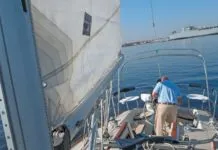
What You Can Learn on a Quick Test Sail

Cabo Rico’s Classic Cutter

Bob Perrys Salty Tayana 37-Footer Boat Review

Preparing Yourself for Solo Sailing

Your New Feature-Packed VHF Radio

Preparing A Boat to Sail Solo

Solar Panels: Go Rigid If You have the Space…

Shoe Goo II Excels for Quick Sail Repairs

When Should We Retire Dyneema Stays and Running Rigging?

Rethinking MOB Prevention

Top-notch Wind Indicators
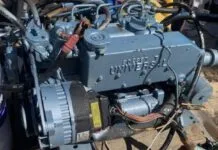
Worship Your Universal M-Series Diesel With the Marinized Kubota Block

Taking Care of Your 12-Volt Lead-Acid Battery Bank

Hassle-free Pumpouts

What Your Boat and the Baltimore Super Container Ship May Have…

Battle of the Teak Cleaners — Snappy Teak-Nu vs. Star Brite

New Seacocks for the Offshore Sailor

Bottom Paint Care

Quick and Safe Sail Cleaning

Are E-bikes Worth the Extra Weight and Cost?

How to Handle the Head

The Day Sailor’s First-Aid Kit

How to Select Crew for a Passage or Delivery

Re-sealing the Seams on Waterproof Fabrics

Waxing and Polishing Your Boat

Reducing Engine Room Noise

Tricks and Tips to Forming Do-it-yourself Rigging Terminals

Marine Toilet Maintenance Tips

Learning to Live with Plastic Boat Bits
- Sailboat Reviews
The PDQ 32: A Comfortable Cruising Cat
Fast and full of unique features, the pdq 32 continues to impress..
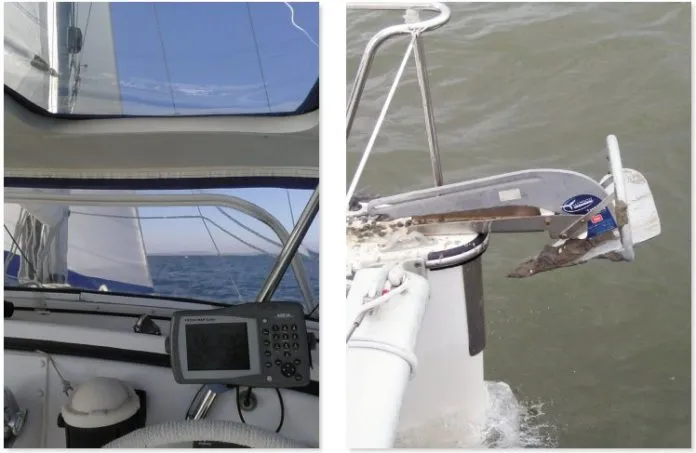
PDQ Yachts in Whitby, Ontario, Canada, launched the Alan Slater-designed PDQ 32 catamaran in 1994 and built 53 of the boats in the following eight years. Practical Sailor first reviewed the PDQ 32 catamaran in April 1997, which happened to be when the test boat for this review update rolled off the production line. Heres a look at what testers have learned from coastal cruising this boat for 18 years and from other owners who live aboard.
The PDQ 32 has proven to be a high-quality boat-bashing through rough seas without a groan-with bulletproof basics. It remains pretty darn quick (PDQ), outpacing much larger boats, and most PDQ 32s today sell for what they cost 15 to 20 years ago ($85,000 to $110,000).
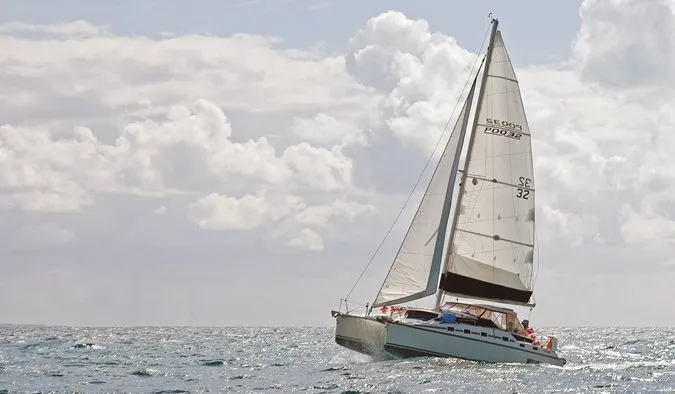
Photo by James Forsyth
The PDQ 32 was kept lightweight- 7,200-pound displacement-through efficient design and the smart use of triaxial cloth, acrylic modified epoxy resin (AME 5000), Klegecell core, and even carbon fiber (in the main beam). As a general rule, fast cats have displacement-to-length (D/L) ratios between 50 and 70, and slow cruisers about 100 to 120. With a D/L ratio of 108, the PDQ 32 could be on the slow side, but the D/L doesn’t tell the entire story.
Its sail area-to-displacement (SA/D) ratio of 19 indicates ample power to drive the hulls; the SA/D increases to 23 with the addition of a genoa. The beam-to-length ratio is 0.52, meaning length overall is nearly twice the beam. While some catamarans, such as the Lagoon 37 (0.60 beam to length ratio) come in much higher, this is a compromise. Ratios greater than 0.5 can lead to bow-burying and increased dockage rates.
Ample bridgedeck clearance and a good ratio of clearance to beam (the wider the boat, the more clearance she will require to avoid slapping) are vital; with 23 inches of minimum clearance over an 8-foot span, the PDQ 32 is nearly immune to bridgedeck slamming, the curse of catamarans that have accepted low clearance in exchange for increased salon headroom and convenience dockside.
Rigs on cruising catamarans usually look rather stubby, and the standard masthead rig on the PDQ 32 is no exception. With an I dimension (the distance along the front of mast from the highest genoa halyard to the main deck) of 40 feet, 10 inches and a sail area of 443 square feet, the PDQ 32 rig is a bit smaller than rigs on monohulls of similar length and has less sail area. For example: The Beneteau First 325 has an I of 41 feet, 7 inches and a 489-square-foot sail area; the Catalina 320 has an I of 43 feet, 7 inches and a 521-square-foot sail area. Also, the Gemini 105M cat carries 515 square feet of sail. However, the PDQ is by far the lightest of these boats, managing to still do well in light air and really scooting when the breeze hits 15 knots.
A tall rig was a PDQ 32 option, most common on the heavier long-range cruising (LRC) version. However, it has not proven to be faster through a range of wind strengths.
The PDQ 32 has a clever, unique cockpit design that allows three levels of seating-all under a hardtop. To help solve the headroom problem in the saloon, the companionway hatch is very wide and slides forward so that just aft of the dinette table, there is full headroom (6 feet, 11 inches) under the hardtop. When the hatch is closed (a rare occasion in most conditions, if you have vinyl windows connecting the hardtop to the deck), most crew must stoop with only 5 feet, 2 inches of headroom. However, when the slider is open, the saloon becomes a delightfully airy place.
Some owners have rigged mosquito netting from the hardtop to the main bulkhead, allowing for great ventilation, even on steamy nights. While the area is not very large, theres plenty of seating, good visibility on the top tier, easy access to the deck, and yet a feeling of protection and shelter.
This setup also means that foul-weather gear is seldom used, as the boat is easily sailed from under the hardtop, and the deck stays dry aft of the beam. In winter, sweaters and windbreakers are the rule in all but sub-freezing weather, since wind is effectively blocked from the helm on most courses.
There is no exterior brightwork-music to a liveaboards ears-and the handrails are stainless steel. The double lifelines, on 24-inch stanchions, have gates at the aft corner and sugar-scoop transoms. Cleats are 10-inch anodized aluminum.
Most of the sail-handling equipment is Harken brand: blocks, cam cleats, and travelers for the self-tending jib, mainsheet, and slider. Primary and secondary winches are located on either side of the cockpit, a mix of two-speed, self-tailing Harken 32s and Lewmar 40s. Rope clutches are Spinlock Easylocks. Some boat owners lead lines back to the cockpit, while others have twin, two-speed winches mounted on the mast.
The PDQ 32s pull-pull steering is by Whitlock. There is also a very workable emergency tiller, and jammed rudders are easily isolated thanks to access through a stern locker. Seacocks are Marelon by Forespar.
Factory ground tackle was most often a 25-pound Delta or Bruce anchor, backed with 50 feet of quarter-inch G4 chain and 150 feet of half-inch, nylon three-strand line led to a windlass and a bow chain locker. Cruising owners have generally upgraded to a 35-pound Rocna or Manson Supreme anchor and 100 feet of quarter-inch G4 chain, again backed with line.
Since these boats typically anchor in shallow water, this allows anchoring on all-chain about 90 percent of the time. A bridle constructed from half-inch line is typically used to secure the anchor rode, as the anchor rollers are mounted on the bows and the crossbeam is not designed for anchoring loads. Windlasses vary, but are most commonly vertical Lewmar Sprints with a combination rope/chain gypsy.
Tankage consists of a 30-gallon aluminum or polyethylene fuel tank aft of the cockpit, a 44-gallon polyethylene water tank under a shelf forward of the dinette, and a 30-gallon fiberglass holding tank that can be emptied offshore by means of a Y-valve and hand pump. The fiberglass holding tanks on our test boat have proven permeation-free after 18 years.
The gasoline tank is located in a sealed, bottom-vented bridgedeck compartment that can serve double-duty as safe storage for portable gas cans and propane cylinders.
The propane system is engineered to current standards, with a forward vented locker sized for two 12-pound tanks. Leak detection in both hulls is tied to a controller and a locker-mounted solenoid valve. Some of these boats have as many as four propane appliances fed from the locker-stove, refrigerator, water heater, space heater-each with a separate propane line.
PDQ thoughtfully located all through-hull fittings and head-related plumbing (except for about 10 inches of waste and intake hose) in a ventilated bulkhead compartment. If the hoses do permeate-as they did on the test boat (see PS April 2012 online)-the odor is isolated from the cabin. However, the holding tank vent is located in an unfortunate position, upwind of salon hatches, but this is easily managed with either proper holding tank treatments or a vent filter (see PS February 2012 and March 2012 online).
The contained through-hulls location proved its worth when the test boat was delivered shortly after its current owner purchased it in 2008. After sea trials, the speed transducer was removed and replaced with a plug; in the process, the O-ring was positioned improperly. Some hours into the two-day trip up the Chesapeake in December (think actual freezing water), the crew noticed a little water dripping past one of the head hoses. Investigation revealed that the forward through-hull compartment had flooded 2 feet deep. The crew pumped it out and realized it was still leaking, but rather than struggle with freezing plumbing in what had become gale conditions, they sailed the boat with the leak for two more days, because the flooding was so well contained. The boat has crash tanks fore and aft (the rudder post is in the latter), a glassed-in holding tank on starboard, and another sealed bulkhead before the cabins begin on each side.
The electrical panel, located in the starboard hull, contains numerous spare breakers; weve not heard of any owner running out. Wiring is well organized and labeled. An inverter with automated transfer switching feeds a 110-volt system sufficient for heating and air-conditioning loads; however, a generator is not standard, so you must be plugged in to shore power or invest in a generator in order to use them.
Batteries include three group 27, deep-cycle wet cells (or an equivalent bank) located in lockers surrounding the cockpit, which makes watering and replacing them easy. Most owners have added solar panels to the hardtop, and some have additional panels above the davits; 170 to 400 watts is typical.
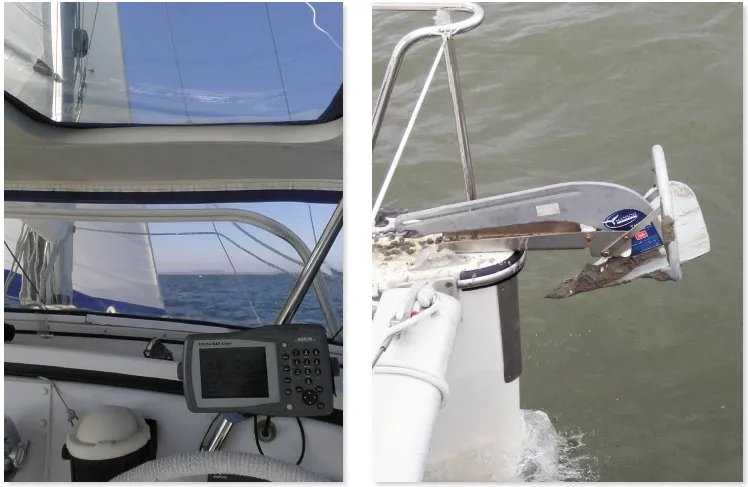
courtesy of Brian Munroe and Lynn Bamberger
The classic PDQ 32 is powered by twin, high-thrust Yamaha 9.9-horsepower outboards mounted in cockpit wells. This central location, 12 feet forward of the transom, places the engines near the boats center of gyration, virtually eliminating cavitation in all conditions and offering the ability to push into 30-knot headwinds.
The LRC version of the 32 has twin, inboard 20-horsepower Yanmar diesels mounted under the aft-cabin bunks. (About 20 percent of PDQ owners opt for the twin diesels.) The diesels offer less noise than outboards and add just a little more speed under power (7.4 knots versus 7.2 knots for the classic), but they reduce speed under sail slightly (about 1 knot), due to increased weight and prop drag. The diesel-LRC version gains a little storage in the cockpit (the outboard wells) but forfeits the cavernous space under the bunks for a net loss in storage.
Whether this storage loss and the weight gain is a fair trade for better propulsion and more reliability depends on whether you sail or motor most of the time, so opinions vary. With twin screws, either version will spin in its own length, and backing into a slip is common practice as boarding the boats is easiest from the stern quarter. However, the twin outboards can be retracted, significantly enhancing performance. Plus, theyre less expensive and can be taken to a shop for service.
Owners of the classic PDQ 32 compensate for lost battery charging power by adding solar panels and a small generator. A rare few add wind generators, but it is pretty common to see a Honda 2000 generator on a PDQ 32. Those who have opted for the new, high-thrust 9.9-horsepower Yamaha outboard conversions can expect a charging capacity of 6 amps at 12 volts each. This, with solar supplementing, is more than sufficient for a cruising couple.
Headroom is 5 feet, 2 inches in the saloon with the slider closed), 7 feet, 2 inches in the amas, and 6 feet, 5 inches in the aft cabins.
In warm weather, the salon bunks become premium, comfortable in dimension and bathed in breeze from well-
positioned fans and overhead hatches. Aft cabins get stuffy owing to their location aft of the cockpit, but hatches provide airflow on even the steamiest night.
While theres a good deal of white fiberglass showing, the overhead liner is vinyl. The cabin sole is teak and holly. Plywood is used for under seats and bunk access boards.
The sleeping cabins are primarily carpeted and have cherry and ash trim. Each has a small hanging locker and several enclosed cabinets for stowage.
There are two private staterooms, complete with six opening ports, numerous cabinets, and cavernous storage areas under the bunk (on the LRC models, this is an easy-to-access engine bay). The mattresses take standard queen bedding. The salon table converts into either a king berth or two twins; there are several versions. We recommend adding quality mattress toppers to the bunks.
With so much interior volume-and no factory air-conditioning (or heat)-good ventilation is a must, and the PDQ does not fall short. Two Bomar hatches above the amas ventilate the forward compartments, and two over the dinette provide salon ventilation; there are four smaller hatches aft, and three in the cockpit. Smaller Bomar side windows line the flanks (13) for a total of 24 opening hatches and ports.
There also are four solar vents in the forward compartments and cabins. Additional light pours in through the smoked acrylic windows surrounding the saloon, providing a rare 270-degree forward panorama, sufficient for watch-keeping during a quick meal.
Galley appliances include a Plastimo propane stovetop, a microwave, and a refrigerator (either a Dometic propane fridge or a top-opening icebox with a cold plate). Because catamarans do not heel much, the propane fridge actually works well, even if its less efficient than an icebox.
While galley counterspace and stowage is limited (there is a large cabinet under the propane fridge, and the bilge in the adjacent cabin is easily accessed), PDQ has worked in a few clever aids such as a pullout spice rack, hinged cutting board, and many shallow cabinets. Its best to keep the gelcoated countertops covered to prevent wear.
Performance
The PDQ 32 is basically a 7- to 10-knot boat. Weve seen 14 knots in non-surfing conditions, using either a spinnaker or genoa, but we don’t recommend it. Although we have long experience with performance cats and know their habits, we only push for short periods and with full attention. We prefer to back off just a little, staying comfortably within the boats performance envelope and enjoying the day.
As a good rule, reefing begins at about 9 knots of boat speed or 20 knots of apparent wind to windward, starting with the main. The LRC model is about a knot slower. Upwind in sustained 15 knots true, expect about 6 to 7 knots with the jib and 8 knots under genoa. Beam reaching in the same winds, weve made 7 to 8 knots and 9 to 10 knots, respectively.
Most PDQ 32 owners buy 90-percent asymmetrical spinnakers for off-the-wind sailing. The tack is controlled with a 2:1 purchase tack line led to each bow cleat, allowing the tack to be moved from side to side to optimize set; it is generally centered through jibes. With a sleeve, setting and dousing the spinnaker is fail-safe, and the sleeve provides sufficient protection while the sail is stored in a bow locker, eliminating the need for a separate sail bag.
It is not hard to see double-digit speeds on the PDQ, but caution is warranted-in a breeze downwind, there is hidden power, and the tack should be kept to windward and the sheet well eased. The spinnaker is best considered a light- to moderate-wind sail, and returned to its bag in favor of the genoa when the true wind is over 15 knots. In a breeze, wing-and-wing dead downwind makes for solid velocity made good and glass-smooth sailing-what cruising in these boats should be about.
In any case, youll pass cruising monohulls up to 45 feet when reaching in a breeze, and pace 40-footers under most conditions. To windward, youll tack through a wider angle, but youll stay with considerably larger boats when the breeze is up. The PDQ 32s PHRF ratings range from 135 to 234, depending on equipment and location.
The PDQ 32 has a deeper draft than its big sister, the PDQ 36-3 feet, 2 inches compared to 2 feet, 10 inches-improving windward performance by a few degrees. Tacking though 100 degrees over ground is possible, if the boat is sailed well and kept moving. The profile view reveals that the keels are unusually far forward; perfect for drying out, but all wrong for tacking.
The keels center of lateral resistance (CLR) is too far forward, relative to the sails center of effort (COE), causing the boat to snap into irons and stay there if given a chance. Back-winding the jib to force the bow through the eye of the wind is a sloppy solution; the boat nearly stops, control is lost, and it may pop back into irons. Backing her to one side, wearing ship, is not reliable either.
The savvy PDQ owner has a different tacking procedure: Accelerate to maximum windward speed by cracking off a few degrees, throw the wheel nearly hard over, release the jib the moment it luffs, and dump the main traveler all the way to leeward when the main breaks (the traveler cleats separately on each tack-pre-set the traveler on the new tack down). Steer well beyond the normal 100-degree tack, placing the true wind on the beam, haul and grind the jib in as soon as it can fill to keep the bow off, and then steer back up to proper course and haul the traveler up as the boat accelerates. The process is simple and quick, once dialed in.
Because the CLR is in front of the COE, keep the traveler a few inches below centerline in lumpy conditions, centered when powered up on flat water. Never place the traveler over center, and always ease the mainsheet enough to preserve twist. Reef the main first; this also helps move the COE forward.
Some owners have added genoas to supplement the stock self-tacking jib. This is a real turbo-charge for the PDQ 32 all around the course, as the keels are large enough to support the additional loading and the genoa brings the COE better in line with the CLR, greatly improving balance.
Because the boat is catamaran rigged (no backstay, shrouds to the extreme beam), the genoa is generally rigged outside the shrouds and sheeted to the extreme beam. The resulting sheeting angle (24 degrees) is too wide for efficient windward work. A successful solution has been to add an inner track and a second set of sheets. The genoa is then sheeted tight against the hardtop, reducing the sheeting angle to 15 degrees and giving a good angle of attack without overpressing the low-aspect keels. The boat can’t point as high as a good monohull, but it can really stomp at 50 degrees true. When reaching, the outer tracks provide beautiful sail shape.
If youre a performance-oriented sailor considering a PDQ 32, look for a boat with a genoa and inside tracks. The difference is real.
Compared to other cats in the same class, the PDQ 32 is as fast in base form, and even faster when tweaked, something the strong but light design seems to encourage. Quality construction has proven to be a boon to owners as well. Sails and moving parts require replacement and upgrade, but the structure and basic systems have been bulletproof.
The center-cockpit setup is different, but testers like the privacy of queen cabins and the expansive forward view, something missing in most cats this size. The salon slider is a unique feature that allows incredible openness in warm weather, requires some stooping in cold weather, and is the cost of high bridgedeck clearance and superior helm visibility. All compromises. Among the few cruising cats of this size, the PDQ 32 offers excellent value.
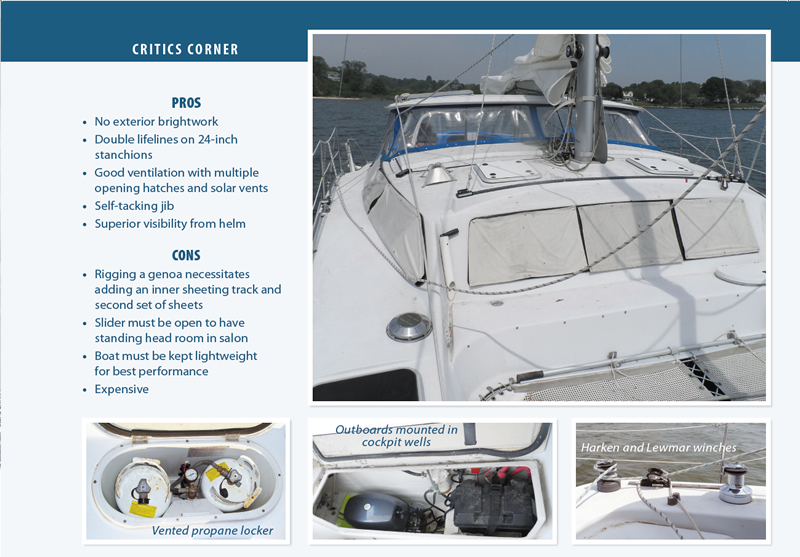
- PDQ: Rugged Quality
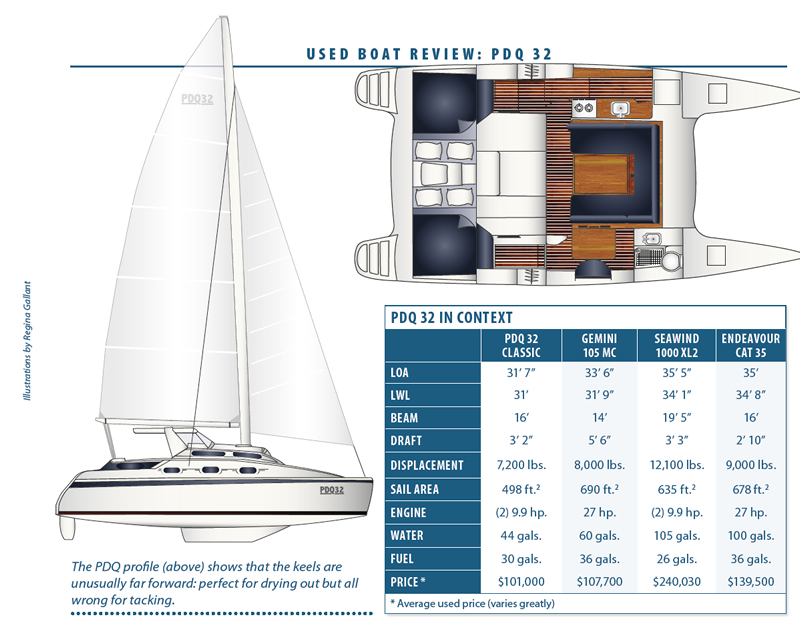
- PDQ Owners Forum
RELATED ARTICLES MORE FROM AUTHOR
Best, detailed, comprehensive review that I can recall reading. Thank you so much!!!
LEAVE A REPLY Cancel reply
Log in to leave a comment
Latest Videos

Beneteau 423: What You Should Know | Boat Review

Buying A Sailboat Is Scary! Yacht Broker Interview

The Great Loop – The Basics

Bottom Paint Showdown – Six Paints, One Winner! (John Stone photo)
- Privacy Policy
- Do Not Sell My Personal Information
- Online Account Activation
- Privacy Manager
- BOAT OF THE YEAR
- Newsletters
- Sailboat Reviews
- Boating Safety
- Sailing Totem
- Charter Resources
- Destinations
- Galley Recipes
- Living Aboard
- Sails and Rigging
- Maintenance

- By Quentin Warren
- Updated: November 2, 2001
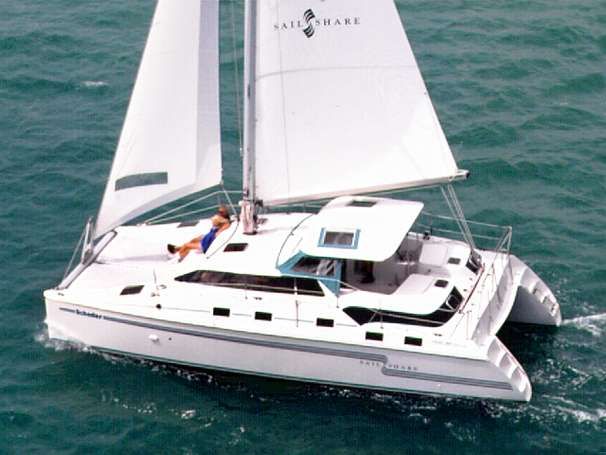
In the world of cruising catamarans, aesthetics take a hit when you cut down on length overall. At issue are a host of conflicting themes — the practical demand for interior volume works against the visual imperative that freeboard be low; the need for bridge deck clearance and standing headroom pushes the cabin profile skyward. What’s graceful, extended and cunning at 45 feet often becomes ungainly in the context of 35.
Which is why Alan Slater’s PDQ 32 is such a remarkable boat. Fully outfitted for long-range cruising, she remains bright, airy and easy to look at. With a nicely proportioned rig and a subtle sloping cabin top, she carries herself like a longer cat and avoids the pitfalls of many of her peers that attempt to consolidate as much mass as possible into a length that won’t accept it. You can cruise or even live aboard this boat quite comfortably, but her scale is such that sail handling and overall maintenance remain uncomplicated.
The deck is safe underfoot with wide gangways, extra-high lifelines, six sets of stainless handholds and the calculated omission of abrupt jogs or steep transitions to throw you off balance. There are deck lockers for anchoring paraphernalia in the bows port and starboard, and a very secure trampoline strung forward of the cabin between the two hulls. Open-air lounging is relegated to this area, also to the cabin top around the mast step and to the stern sections where boarding steps are molded into the transoms.The cockpit is smallish and deep, well protected from the elements by a rigid Bimini. Given its depth it offers a secure haven for kids, and with the main companionway hatch that stretches clear across the cabin shoved forward it becomes a pleasant extension of the saloon. The Bimini is strong enough to stand on when tending the mainsail, and cut-outs allow you to look aloft from the helm under way to check on trim. Care should be taken to avoid bumping one’s head on it when entering or exiting the cockpit area.
Indeed, the Bimini structure and sliding cabin top section constitute a major feature aboard this boat and one that PDQ has sought to refine in more than two years of design trial and error. Early problems with the sliding element involving watertightness and ease of operation have been resolved, as have height and interference problems associated with the Bimini. The result is a unique cockpit space that offers the shade and protection of a pilothouse while retaining an outdoorsy ambience.
PDQ is a good builder with a solid grasp of modern materials. Where exotic components can offer calculable advantages, they are used. Hulls and deck are laid up with knitted triaxial fiberglass fabric in a matrix of AME 5000 (Acrylic Modified Epoxy) resin. Klegecell rigid foam is used for lightness and stiffness in the deck and in the hulls above the waterline; solid glass is spec’d below the waterline. All the coring is vacuum-bagged to optimize the resin ratio and primary bond. A fiberglass beam reinforced with carbon supports the mast step. An aluminum beam is fitted bow-to-bow and rigidified in compression by a pelican striker to accept headstay loads. Structural bulkheads are taped carefully to the hulls with X-weave knitted fabric. There are watertight crash compartments in each hull forward and aft. The rig is set up with diamond stays, and aft-led uppers are secured to stainless steel chain plates bolted into primary reinforcement at the hulls outboard.
The PDQ 32 is available in two basic configurations — the Classic version, offered with two retractable 9.9-horsepower four-stroke Yamaha outboard engines cleverly deployed from pods beneath the cockpit lockers, and the LRC (Long Range Cruiser) version, offered with twin 20-horsepower Yanmar inboard diesel sail drives located in shielded-engine compartments aft. Both give you dual propulsion well separated athwartship for great close-in control. The LRC package offers more power and considerably more alternator charging capability; the Classic package is simpler and lighter.
Both versions are wired for 12-volt and 110-volt circuitry. Freshwater capacity is 90 gallons, pressurized. All plumbing output is above the waterline through the insides of the hulls, and intakes below the waterline are fitted with ball-valve-type seacocks. Wherever possible, fiberglass and PVC pipes are used as fluid conduits in lieu of hose for strength and abrasion resistance.Below, sensitive glasswork combined with just the right amount of cherry trim makes for a delightful interior. The main saloon accommodates up to six people around the dinette and spills congenially into the galley that occupies the port hull forward. Cozy double berths with shelving and locker storage are located in the sterns. The starboard hull amidship includes the nav station with a fold-down chart table and forward of that a one-piece modular head with its own shower.
We went for a pleasant sail aboard the 32 off Newport, Rhode Island, in a steady 15-18 knot sea breeze. The boat relished the moderate conditions and rode smoothly and powerfully through a sizable chop at the mouth of Narragansett Bay. We kept speed in the solid sixes and response at the helm was excellent, even through tacks. There was no apparent slapping on the underside of the bridge deck, and acceleration was quick and positive. In the breezy air we encountered, the behavior of the boat was top-notch.
Suffice it to say, PDQ has brought the 32 along to a commendable level of production and finish. It is definitely an owner-optimized vessel capable of reflecting a host of personal touches, and the company stands behind whatever its clients want their boats to be. Certainly in its size and price range, it is a significant cat.
PDQ 32 Specifications:
LOA: 31′ 7″ (9.63 m.) LWL: 31’0″ (9.45 m.) Beam: 16’0″ (4.9 m.) Draft: 3’2″ (0.96 m.) Disp: Disp: 7,200 lbs. (3,266 kgs.) Sail area: 507 sq.ft. (47.1 sq.m.) Mast above water: 45’0″ (13.7 m.) Length/Beam (hulls): 8:1 Bridge Clear: 40″ (fwd.), 23″ (aft) Cabin headroom: 6’11” (open), 5’4″ (closed) Disp/Length: 108 SA/Disp: 21.8 Fuel tankage: 30 gal. (114 ltr.) Water tankage: 47 gal. (178 ltr.) Auxiliary: 2 x Yanmar 9.9 4-cycle outboard Designer: Alan Slater Base price: $129,500 – $139,500 PDQ Yachts USA 309 Third St. Annapolis, MD 21403 Phone: (410) 268-3700
- More: 2001 - 2010 , 31 - 40 ft , catamaran , Coastal Cruising , multihull , Sailboat Reviews , Sailboats
- More Sailboats

A Gem in New England

Thinking of a Shift to Power?

TradeWinds Debuts 59-foot TWe6 Smart Electric Yacht

Sailboat Preview: Dufour 44

Good Bread for Good Health

Center of Effort

The Halfway Point: Sailing to Bermuda
- Digital Edition
- Customer Service
- Privacy Policy
- Email Newsletters
- Cruising World
- Sailing World
- Salt Water Sportsman
- Sport Fishing
- Wakeboarding
Did You Know That We Offer Contract to Closing Services? Click Here to Find Out More.
Need Marine Financing? Apply Here With Our Partner, First Approval Source
- Catamaran Interviews
- Catamaran Reviews
- Buying Advice
- Selling Advice
- Woods Design Advice
- Americat 3014
- Aquila 44 Yacht
- Balance 526
- Bali 40 Catspace
- Beneteau Blue II
- Broadblue 346
- Broadblue 38 Prestige
- Broadblue 385
- Broadblue 435
- Broadblue 46
- Catalac 10M
- Catalac 11M
- Catalac 12M
- Catalac 900
- Catana 42 S
- Chris White 48 Voyager
- Chris White 55
- Corsair F28 R
- De Villiers
- Dolphin 460
- Endeavour 30
- Endeavour 35 Victory
- Endeavour 36
- Endeavour 44
- Endeavour 44 TrawlerCat
- Fortuna 36 Island Spirit
- Fortuna 401 Island Spirit
- FP 32 Maldives
- FP 35 Tobago
- FP 37 Antigua
- FP 38 Athena
- FP 39 Fidji
- FP 40 Lavezzi
- FP 40 Lucia
- FP 40 Summerland MY
- FP 41 Lipari
- FP 42 Astrea
- FP 42 Venezia
- FP 43 Belize
- FP 44 Helia
- FP 44 Orana
- FP 46 Bahia
- FP 46 Casamance
- FP 48 Salina
- FP 56 Marquises
- FP 57 Sanya
- FP 60 Eleuthera
- FP Saona 47
- Gemini 3000
- Gemini 3200
- Gemini 3400
- Grainger 420 Mystery Cove
- Hirondelle 7M
- Lagoon 37 TPI
- Lagoon 42 TPI
- Lagoon 43 PC
- Leopard 39 PowerCat
- Leopard 45 Classic
- Leopard 47 PowerCat
- Leopard 51 PowerCat
- Leopard 53 PowerCat
- Maine Cat 30
- Maine Cat 41
- Matrix 450 Vision
- Matrix 760 Silhouette
- Maverick 400
- Maverick 420
- Maverick 440
- Nautitech 40
- Nautitech 442
- Nautitech 46 Open
- Nautitech 47
- Outremer 40
- Outremer 45
- Outremer 50 Standard
- Outremer 55
- Privilege 37
- Privilege 39
- Privilege 42
- Privilege 43
- Privilege 435
- Privilege 45
- Privilege 465
- Privilege 48 Transcat
- Privilege 482
- Privilege Serie 5
- Prout 31 Quest
- Prout 33 Quest
- Prout 34 Event
- Prout 35 Snowgoose
- Prout 37 Snowgoose
- Prout 37 Snowgoose Elite
- Prout 38 Manta
- Prout 39 Escale
- Royal Cape 45
- Royal Cape 530 Majestic
- Royal Cape Majestic 500
- Sailcraft 30 Iroquois
- Sailcraft 32 Comanche
- Sailcraft 35 Cherokee
- Sailcraft 41 Apache
- Sailcraft 44 Apache
- Wildcat 350
- Seawind 1000
- Seawind 1160
- Seawind 1200
- Seawind 1260
- Seawind 1600
- Solaris 36 Sunrise
- Solaris 36 Sunstar
- St Francis 44
- St Francis 48
- St Francis 50
- Stealth 11.8
- Heavenly Twins 26
- Ocean Twins 38
- Voyage 380 Maxim
- Voyage 400 Norseman
- Voyage 430 Norseman
- Voyage 450 Cabriolet
- Voyage 47 Mayotte
- Wharram 38 Tiki
- AMI 320 Renaissance
- Woods 22 Wizard
- Woods 35 Banshee
- Woods 35 Flica
- Woods 36 Scylla
- Woods 36 Vardo
- Woods 38 Transit
- Woods 40 Meander
- Xquisite X5
- Xquisite X5+
PDQ 32 Review with Aurora and Dennis of S/V Serenity
- Post author By Diane Selkirk
- Post date March 6, 2021
- 8 Comments on PDQ 32 Review with Aurora and Dennis of S/V Serenity

We spoke with Aurora and Dennis who have a 1998 PDQ 32 named Serenity that they bought in 2017. They tell us about why they chose the PDQ 32, the strengths and weaknesses of the model, and why it has been the perfect catamaran for them. They compare the PDQ 32 to Geminis, Maine Cat 30, Seawind 1160. Please watch the interview below and read on for a transcript with additional photos to illustrate the features spoken about.
Key Takeaways of the PDQ 32
- Inexpensive, simple learning catamaran that allows for weekend sailing with kids and longer travels as a couple
- Light and small enough that you can manhandle at docks which lowers stress and likelihood of scratches.
- Powered by twin 9.9 HP outboards which are inexpensive to maintain, easy to repower, and can be tilted up to gain 1 knot of speed. Wonderful simple sailing.
- Loves going downwind and sails beautifully with asymmetrical.
- Higher bridgedeck clearance than other similar size pocket catamarans like a Gemini 105 MC.
Challenges of the PDQ 32
- Tall rig version and has excessive weather helm. Difficult to balance sails especially with smaller self tacking jib.
- Unconventional looks. Their nickname for the boat is the alien bug.
- Single lane traffic down below because of narrowness of design.
- No dedicated shower down below. Single wet head.
Can you tell us a little bit about how you came to choose a PDQ as your boat?
We had a 16-foot little day sailor that we had taken around Lake Champlain and some other places, and we were looking to get a little bit larger boat that we could take the kids on and go longer than a weekend sail.
We looked around at a lot of boats, but we’ve got three kids to put through college. So we were going for a little bit of a budget boat, maybe a little bit of a learning boat. We’re looking at small catamarans like Geminis and PDQs and some others like that, and this one just came on the market in Rhode Island. We were not seriously looking when we bought it. We just happened to be visiting a friend in Rhode Island and you’re like, “let’s look at this boat,” and it just kept checking all the boxes and it just worked out.

Had you known much about the PDQ before you went aboard that one in Rhode Island? Had you narrowed down to that model?
We knew we were looking in the low 30-foot range for a catamaran, and we’d chartered Gemini, so we’d been on a similar sized boat. We’d spent a fair bit of time with Mike and Rebecca from Zero to Cruising, and had been following their blog. They were on a PDQ 32 for their exploration of the Caribbean. So we’d been following them for a couple of years and we’d even sailed with them, not on their PDQ boat, on their next boat, which was an Amel.
One of the things that struck us about our time with them, was that they were on this beautiful cruising boat, on this beautiful Amel, which is what Delos has. It’s around this beautiful cruising boat, and they talked about their PDQ 32 like it was their first born baby and they missed it constantly, and we just sort of looked at each other like, “we’re on their Delos boat, but they missed their PDQ 32 like crazy.”

Not long after that one, when we stumbled across this PDQ 32, which there’s not a lot of small catamarans in northern New England. So it’s kind of rare to find one on the hard, and we stumbled across this PDQ 32 and it really did just tick all the boxes, and we said, “let’s do it now!”

The other piece that I will add, is that ultimately, we’re part-time cruisers, so we live in New Hampshire and we sail part-time in the summer, because that’s what works well in our lives. We do ultimately have plans to go a little further than that, and spend more time on our boat, but we think that probably won’t happen until our kids are out of the house. So having this little boat was actually okay right now, even though we have, sometimes, too many teenagers on this little boat, but not for long periods of time.
When we’re ready to go a little further, it’s just fine for a couple, it’s big enough for a couple. So we thought it was a both a good boat for us for now, because of the price and because of the size, but also probably a good boat for us longer term if we decided we wanted to go further. We would be able to do it together on that boat.
That’s cool. The boat for right now is a big deal but what are some of the things that you think are the best things about her for you?
The boat is super simple. The very few systems, the sails aren’t so big that we can’t handle them, even though we don’t really know what we’re doing. We’re new! We went to sailing school in 2015. So we were new sailors when we bought her, and she wasn’t intimidating at all. Really, she’s been a good teacher for us. The boat’s not so big we can’t manhandle it off any dock, and we can get out of scrapes that we wouldn’t be able to with a 40-foot boat, so that’s been good.

She’s powered by outboards, which is a little weird. So two 9.9 HP outboards, which is what a lot of people have on their dinghy, is what powers our boat. But a lot of people have those 9.9’s on their dinghy, that’s where most people see him, that’s what powers our catamaran are two of those.

One of my favorite things is that you can lift him up and we gain a knot of speed. Pretty much every time we lift up those motors, get them out of the water. We have no props in the water all the time, so we don’t have growth on our props. When we have to repower, and we’ve now half repowered, it’s not that big a deal to lift an outboard out of this boat and get a new one. It’s just not that big a deal, so I really love that about her.

So what about criticisms or things that you think could be changed to make her better? You found anything like that?
We’ve had problem with the sail balance a bit. Our boat especially, I think they put on a larger mast in an effort to put on more sail area, but that meant that the boat really wants to go to weather, especially with the self-tacking jib that it came with.

The self tacking jib is lovely for single-handing, just so easy to sail, but she just didn’t sail really well with the jib on. We did get a Genoa, and it sails much better, obviously in low wind, and it’s better balance. Aurora’s making a main sail right now, which has been fun. We made our asymmetrical spinnaker last last year, so that was fun. We’ve gotten into a lot of sewing for boats in our time, which is a big surprise to me, because I have to say, I was anti-sewing. I didn’t sew and now I make sails.

I guess the sails aren’t so huge, you could probably fit them in your home.
Not flat! But you can make a sail in our house. We’re hoping the new main sail helps with the sail balance too. The other thing I would just say, is that this boat does not have conventional looks. When we pull into a harbor, people go, “where’s your boat?” We go, “Oh! We have the alien bug!” They are cute but they look really strange. We’re in Rhode Island, where there are all these beautiful wooden boats, with classic lines. Often, we pull into an anchorage and I’m like, I can’t even believe they let us in here, because we don’t look like we belong. But the America’s Cup boats are pulling up, going right by us, and we’re like, “what do they think about our boat?” It does look kind of funny.

I will say the design, every square inch of this boat has been well thought out. Even though it’s a really small boat, it’s so functional. I think the only thing that is hard for me about it is, there’s only single lane traffic in the boat. Everything is narrow, and two people can’t pass in any place. It’s not an island bed, you’re climbing over your partner. Those kinds of things of being on a small catamaran. We don’t have a separate shower, although I prefer my showers outside anyway. So that’s not so bad. It’s a small space, but it is very very well designed. So it doesn’t feel dysfunctional in any way. It just is not large.
Why don’t we pop into the interior then? Tell us a little bit about how you use it for your family and go through that a little bit. Where’s the galley and how does that work for you?
It’s galley down. The galley is down in the port hull, which I wasn’t sure how I would feel about that, but I actually love it. It’s really lovely. It’s easy for cooking underway, because it’s just really comfortable. It’s narrow enough that you can brace yourself really easily if it’s a little boisterous out. The galley is very, very functional. It has two cabins, both are in the aft, so they are fairly comfortable. There’s one head, which, if you have too many teenagers on the boat, it can be a bit of a challenge.

Often, when we have too many teenagers, those are the moments that we choose to spend a night or two on a dock, so we get some extra toilets and showers and stuff. We have two cabins, and then sometimes when we have a lot of people on board, the salon table lowers down and it converts into a oversized king-size bed. We have put three teenagers there.

The other thing we do that’s kind of funny when we have too many teenagers is, we will pitch a tent on the forward trampoline, because the trampoline is just the right size for about a four person tent. So we have been known to pitch a tent on our trampoline and send teenagers up to sleep on the back.

That’s fantastic. Maya had a lot of sleepovers on our nets, but because we’re in the tropics, she didn’t need the tent. But I think the tent sounds fantastic, it sounds like a lot of fun. Are you able to sit everybody at the table and all that kind of thing works?
Yeah, it easily sits six. Six comfortably, eight a little cozy.
And storage?
We have no problem with storage, there’s a massive amount. Probably too much storage for weight. Like other catamarans, if you filled up all your storage, you would be really really slow. There’s lots of storage under the beds, and there’s adequate cabinets. Some of the cabinets are quite small, but it all works. There’s a lot of storage underneath the salon area. The storage is perfectly adequate for what we do. I don’t know how we’ll feel about it if we’re living on it full-time. We live in a pretty good-sized house right now, so it’ll be a little bit of an adjustment. But for what we’re doing, a couple weeks at a time, it’s perfect.
Tell us a little bit about sailing then. How does she sail and what are her favorite conditions?
She loves going downwind, wing on wing with an asym up. She loves going downwind like lots of catamarans, but she’s pretty comfortable in all directions. With the Genoa on, she points better than she did with the jib, which is nice.

We’re kind of fair weather sailors, which is great for a boat like this. This is not a boat to sail through hurricanes, so we haven’t sailed in really really boisterous conditions, but we’ve been in some ways in chop, and she does well. I think compared to boats of her size, like the Gemini that we sail on, we have much higher bridgedeck clearance, we have much better shaped hulls. You don’t feel like you’re pushing through the water. The 16-foot beam is really nice. I can’t imagine a boat the same size sailing any better.

So you’ve been in light winds, moderate winds. You haven’t been into bigger winds at all to see how she does in heavier weather?
We avoid those.
Fair, so do I. Totally, totally agree.
We’ve occasionally had higher winds here and there. They’re by surprise for short periods of time, generally short distances. She’s always been fine. I mean there’s three reefing points, it’s on a furling jib. You can put out just a scrap ahead sail. She’s easy to get the sail really way down, to make her more comfortable and in higher winds. But those are not our chosen conditions for sailing.
That’s a good call. How about motoring? How’s the speed under motor and maneuverability?
With both motors, you can easily get five knots, maybe six if you redlined it. But a lot of times, we’ll just put one motor down and do three and a half knots if we’re not in a rush. We get about a half gallon per hour, per motor, so we can go for a while. We go pretty far on not much, and we usually fill the tank maybe twice a year, and we sail as much as we can. Also, we do really love to sail, so we motor some.
We’re Rhode Island sailors, so the farthest we’ve gone, so far, is Nantucket. We’re doing day hops here and there, and although we’ll go for a few weeks at a time, we’re hopping 30 miles, 40 miles, maybe 50 miles every once in a while, in a day. We’re not going really long distances.


Like around here. And those are nice distances that you can do within a day, and get in and enjoy the sunset. I think a lot of what it’s about. How about getting in and out of docks, and that maneuverability and that visibility? Do you have any issues there?
No, the engines are far enough apart that we can spin the boat pretty easily. The design of the helm and the visibility is kind of unique. A lot of catamarans have the salon between the helm and the front of the boat. With this boat, there’s a sliding hat, like the roof opens. It’s like a convertible car, so there really isn’t anything between you and what’s in the front of the boat, and the helm’s raised just a little bit so you can easily see over everything that the cabin has. I think you can see all four corners of the boat, just about, from the helm. The two engines really do give excellent maneuverability.

The only time when you maybe don’t always feel it, is in a lot of current, because 9.9 outboard are still 9.9’s. In a lot of currents sometimes, you sort of feel like, “am I a little under powered here?” But we’ve had no trouble docking her at all. I mean, she has a 16-foot beam, so you know it doesn’t fit everywhere, but she’s not hard to dock.
That’s cool. So the future of the boat, do you have any projects that you’re working on, or anything that you think needs changing aside from the sails that you’ve already done? Is there anything else?
Always. We put in lithium batteries and did a big solar project for it, and that has just made the boat such a joy to not have to have a generator, to never plug into shore power.

That’s been great, and in fact we can even run a little air conditioner. We can run that off the batteries now, so it’s pretty awesome. That was a great improvement. Other than that, we’ve done all the canvas, and we’ll have all all new sails this year.

What year was she? I forgot to ask you that.
She’s a 1998. Kind of older, right? So there’s constantly projects. I’ve gotten into sewing, so I think there’s going to be some new cushions coming, maybe next winter. We’ll see. That kind of work. With the big hardtop doing the dodger all the way around, we knew one of those that worked for us was just a huge project that was awesome. Every time we unzip those windows we’re like, “Yes! This is the best thing ever!”

That’s cool, yeah.
We’ve done a stack pack, we made our own stack pack. All those things have have made her really lovable. We don’t have any really big projects on the horizon right now. We’ve done all our big ones. Now, we’re just waiting to see what breaks next.
That’s fair. So here’s the tricky question. If you were going to swap her for another boat what would you swap her for, if anything?
We chartered a Maine Cat 30 in the Abacos, and it’s kind of a similar boat, but a little more sporty, and with a daggerboard. So the performance was a little bit over. Also a little lighter, very lightly loaded.

It doesn’t have all the teenagers aboard!
I would look at a Maine Cat 38 probably. You like Seawinds, right? I really do like Seawinds, although I’ve never sailed one. I have always had a thing for Seawind 1160 Lights, which again, have the outboard engines that you can lift up.

I’m really curious about potentially going electric, potentially on one side. So half electric. I’ve thought a lot about that, and that’s part of why the outboard motors are a little more appealing to me. Once we get there, once we really think we’ve got the right batteries, and the right electric motors, we could easily swap out for one electric, and sort of do that as a little bit of a test. We’ve had great experience with our Torqeedo on our dinghy. We’re just like, “no oil changes, super easy maintenance, just goes every time.” We love it.
If people are looking at a PDQ 32, what tips would you offer? What would you have to say?
I don’t know, other than enjoy it.
Are they are all pretty much the same?
The 32s are very similar. I think there is a long-range cruising version that has inboard. There’s also a 36 that is very quite similar, but a little bit bigger, and they have a lot of overlapping features. It’s a lovely boat if you want a catamaran that’s around a hundred thousand dollars, instead of three, four times that. And you’re ready to have a smaller boat that is very very functional, well-designed, but also older. They’re all at this point, I think, 20-years old, almost. They stopped making them almost 20 years ago, well more than 10, 15 years ago, so they’re all a little older.
You’re gonna have those regular upkeep things that you need to pay attention to, but it’s a lovely boat, especially for relatively new sailors. We knew we wanted a catamaran, and four years ago we would not have been able to buy a Leopard 47. We’ve really fallen in love with this little boat. We still get on it, and I mean every single time we sail it, we have this moment. We’re like, “this is just the right boat for us right now, just the right boat for us,” which is a lovely feeling to have about your boat.

Oh, for sure, yeah. I think love gets you through an awful lot of boat repairs, and projects, and stuff, and enjoying them. Well, thank you so much for spending the time talking to us about your PDQ 32.
Thank you for having us.

- Tags Catamaran Interviews , Catamaran Reviews

By Diane Selkirk
I love to travel and have spent the past seven years sailing with my family aboard our 40 Woods Meander catamaran - traveling from B.C.'s north coast, to the west coast of the US, Mexico, the South Pacific, Australia, New Zealand, South East Asia, across the Indian Ocean to South Africa and on to St Helena, South America, the Caribbean and Central America.
8 replies on “PDQ 32 Review with Aurora and Dennis of S/V Serenity”
I really like the article. I have a PDQ36 and have sailed the 32s. I found the article quite accurate. Great job on selecting questions too.
Thank you! Means a lot to us to get this feedback. I see you have a media production company and own a PDQ36, so it sounds like your feedback really means a lot! We are looking to cover PDQ 36 if you are available or know someone who would be interested in being featured. Contact us if so.
Hi Richard: I’d be happy to provide more info, a tour, etc. I love this little catamaran. Feel free to contact me anytime.
I am in the process of downsizing to a PDQ 36. It is my retirement boat, after sixteen years of owning and captaining a Leopard 45 in charter in the BVI. I will have more thoughts on downsizing (instead of upsizing!) in a few months. I am also an ASA instructor, so I look forward to figuring out any differences in boat handling, other than the size, etc.
Sounds like a great plan for retirement. We have a review coming out next week on the PDQ 36 which hopefully you will enjoy. Stay tuned.
I have the tall mast and found the original main sail tended to have too much belly even with outhaul as far as it would go. I replaced the main with a loose footed laminate radial by North Sails and I don’t really have trouble getting balance. When winds get up over 15 knots it does balance better with the first reef in.
We also have a PDQ32 and love it. We have taken ours from Virginia, USA to Guatemala and many points in between. For a couple there is plenty of room and storage. She does seem underpowered when motoring directly into the wind but otherwise is perfect! We haven’t added an asymmetrical sail yet but that is high on our priority list. Even with the stock sails and fully loaded, we have seen 8-9 knots of speed on a beam reach but we tend to slow her down at that point. Thanks for the interview, it was great to get another owners perspective!
The PDQ32 is a really good boat and really should be in the sailboat hall of fame for it’s compact unique designs. I also own a F-27, which is in the sailboat hall of fame, the PDQ32 is equal to that boat in many, but different, ways.
Leave a Reply Cancel reply
Your email address will not be published. Required fields are marked *
Save my name, email, and website in this browser for the next time I comment.
JavaScript seem to be disabled in your browser.
You must have JavaScript enabled in your browser to utilize the functionality of this website.
Edwards Yacht Sales

- 866.365.0706
1994 PDQ Yachts 32
- Crystal River, FL, US
Yacht price
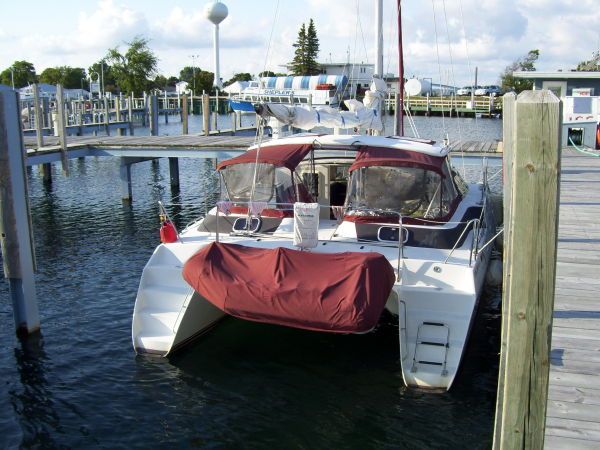
- Email Broker
- Call Broker

This is an excellent example of the PDQ32. She spent until 2008 sailing the Great Lakes and was stored indoors in heated storage at least 8 months each year. Since being brought down on her own bottom, she has been lightly used and well maintained. Check out the detailed listing and you will see this is a boat worth further consideration.
PRICE REDUCED 5/20/2011 by $13,100 to $99,900
Specifications
Descriptions, basic information, dimensions & weight, tank capacities.
- View Option

- Hot & cold pressure water
- Double sinks
- Refrigerated box; 120v and propane
- Propane stove (2 burner)
- Manual marine head
- Vanity & sink
- Holding tank
- Handheld shower
- Shower sump
- Autohelm Autopilot
- Furuno radar
- Depth meter
- Uniden LTD950 VHF w/external speaker
- Lowrance X515 Fish/Depth; new 2009
- Garmin GPS 376C w/XM antenna
- TackTick wireless wind meter
- Alpine CD Player w/six speakers
- LG TV in salon
- 110v system w/panel
- Heart 2000 Inverter/Charger/Monitor
- 30amp power cord
- 15amp to 30amp connector
- 50amp to 30amp connector
- 12v outlet at helm
- TV/VHF antenna
- Two 12v batteries; new 2009
- Bow and stern rails
- Lifelines w/boarding gates
- Anchor roller
- Cockpit enclosure
- Cockpit cushions
- Two front cushions
- Six life jackets
- Dingy davits
- Stainless steel full bow protectors
- Plastic floor mat in cockpit and head
- Todd helm seat
- Bosun's chair
- Fender boards (2)
- Emergency radar reflector
- Pressure hot water system
- Bruce 10kg anchor
- 20' chain & 150' rode
- Danforth anchor with 100' rode
- Two LP tanks (10lbs)
- Engine tachometers
- Manual and electric bilge pumps
- Aluminum mast and boom
- Self tacking jib
- Shaffer furling system
- Mainsail cover
- ASM Spinnaker with sleeve, sheets and blocks
- Spinnaker winches
- Spinnaker bag
- Three winch handles
- Four halyards
Presented by
Joe weber 0 listing(s).
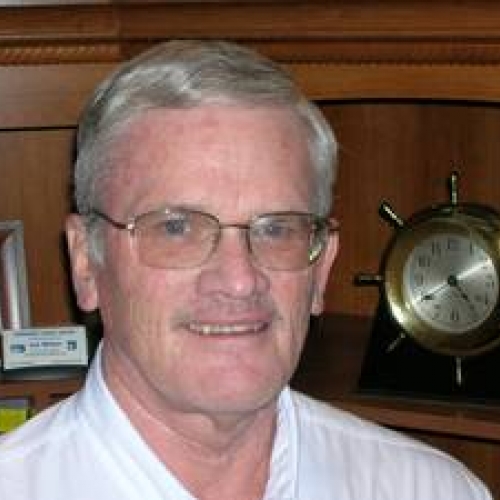
- 941.224.9661 727.449.8222
- View Profile
Manufacturer
Length Range Length Range
Year Range Year Range
Price Range Price Range
QUICK SEARCH BY:
Buyer services, featured yacht.

2021 Stamas 390 Aegean

1996 Tiara Yachts 3500 Express

1981 Hatteras 48 Motor Yacht

2007 Meridian 391 Sedan
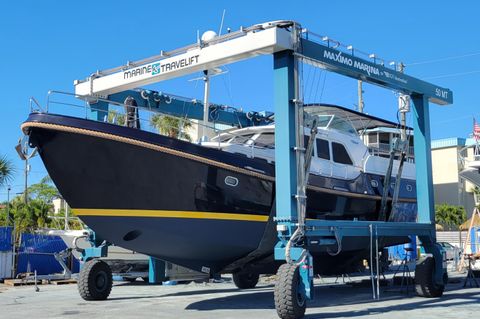
2002 Linssen 470 Grand Sturdy
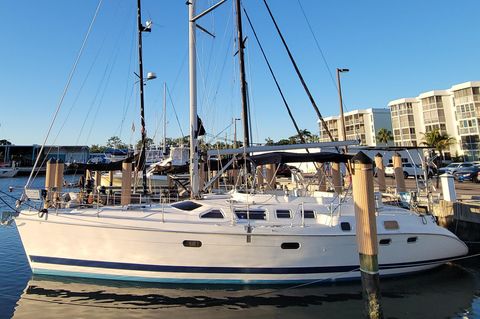
2002 Hunter 450 Passage
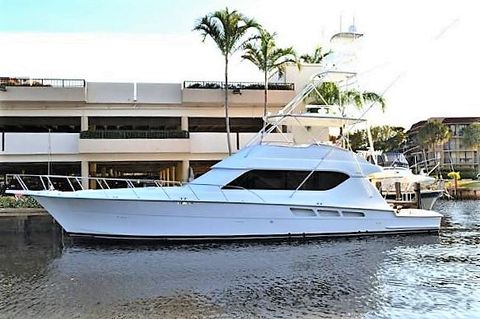
2001 Hatteras Sportfish
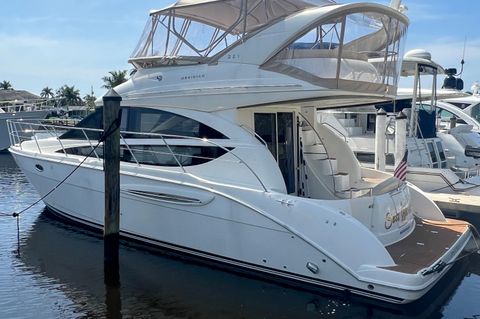
2011 Meridian 391 Sedan

1985 Ocean Yachts 55 Super Sport
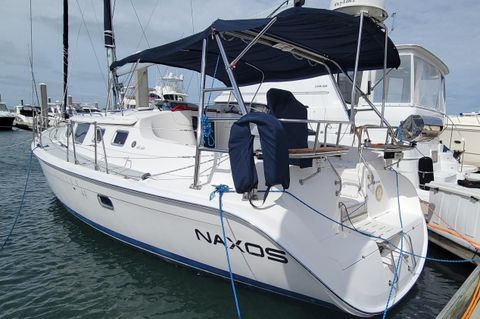
2007 Hunter 44 Deck Salon

2007 Sea Ray Sundancer 40

1985 Morgan 31 Off Shore Fishing Cuddy
- Google Plus
- Boats For Sale
- Brokerage Services
- Sold Yachts
Whether you are buying or selling your next boat or your first boat, one of Edwards Yacht Sales 45+ Professional Yacht Brokers throughout the Southeast are here to assist. Since 2003 we have acted as our clients trusted advisor throughout the entire process from shopping, to making an offer, to sea trial and survey, to closing.
Corporate Office: 510 Brookside Drive Clearwater, FL 33764
Email: [email protected]
Phone: 727.449.8222 Toll Free: 866.365.0706 Fax: 727.298.0456
Copyright © 2024 Edwards Yacht Sales Do Not Sell My Personal Information Powered by YachtCloser

We have placed cookies on your device to help make this website better.
You can use this tool to change your cookie settings. Otherwise, we’ll assume you’re OK to continue.
Some of the cookies we use are essential for the site to work.
We also use some non-essential cookies to collect information for making reports and to help us improve the site. The cookies collect information in an anonymous form.
To control third party cookies, you can also adjust your browser settings .
Great choice! Your favorites are temporarily saved for this session. Sign in to save them permanently, access them on any device, and receive relevant alerts.
- Sailboat Guide
Pdq 32 is a 31 ′ 7 ″ / 9.6 m catamaran sailboat designed by Steve Killing and built by PDQ Yachts starting in 1995.

Rig and Sails
Auxilary power, accomodations, calculations.
The theoretical maximum speed that a displacement hull can move efficiently through the water is determined by it's waterline length and displacement. It may be unable to reach this speed if the boat is underpowered or heavily loaded, though it may exceed this speed given enough power. Read more.
Classic hull speed formula:
Hull Speed = 1.34 x √LWL
Max Speed/Length ratio = 8.26 ÷ Displacement/Length ratio .311 Hull Speed = Max Speed/Length ratio x √LWL
Sail Area / Displacement Ratio
A measure of the power of the sails relative to the weight of the boat. The higher the number, the higher the performance, but the harder the boat will be to handle. This ratio is a "non-dimensional" value that facilitates comparisons between boats of different types and sizes. Read more.
SA/D = SA ÷ (D ÷ 64) 2/3
- SA : Sail area in square feet, derived by adding the mainsail area to 100% of the foretriangle area (the lateral area above the deck between the mast and the forestay).
- D : Displacement in pounds.
Ballast / Displacement Ratio
A measure of the stability of a boat's hull that suggests how well a monohull will stand up to its sails. The ballast displacement ratio indicates how much of the weight of a boat is placed for maximum stability against capsizing and is an indicator of stiffness and resistance to capsize.
Ballast / Displacement * 100
Displacement / Length Ratio
A measure of the weight of the boat relative to it's length at the waterline. The higher a boat’s D/L ratio, the more easily it will carry a load and the more comfortable its motion will be. The lower a boat's ratio is, the less power it takes to drive the boat to its nominal hull speed or beyond. Read more.
D/L = (D ÷ 2240) ÷ (0.01 x LWL)³
- D: Displacement of the boat in pounds.
- LWL: Waterline length in feet
Comfort Ratio
This ratio assess how quickly and abruptly a boat’s hull reacts to waves in a significant seaway, these being the elements of a boat’s motion most likely to cause seasickness. Read more.
Comfort ratio = D ÷ (.65 x (.7 LWL + .3 LOA) x Beam 1.33 )
- D: Displacement of the boat in pounds
- LOA: Length overall in feet
- Beam: Width of boat at the widest point in feet
Capsize Screening Formula
This formula attempts to indicate whether a given boat might be too wide and light to readily right itself after being overturned in extreme conditions. Read more.
CSV = Beam ÷ ³√(D / 64)
Embed this page on your own website by copying and pasting this code.
- About Sailboat Guide
©2024 Sea Time Tech, LLC
This site is protected by reCAPTCHA and the Google Privacy Policy and Terms of Service apply.
PDQ 32 Detailed Review
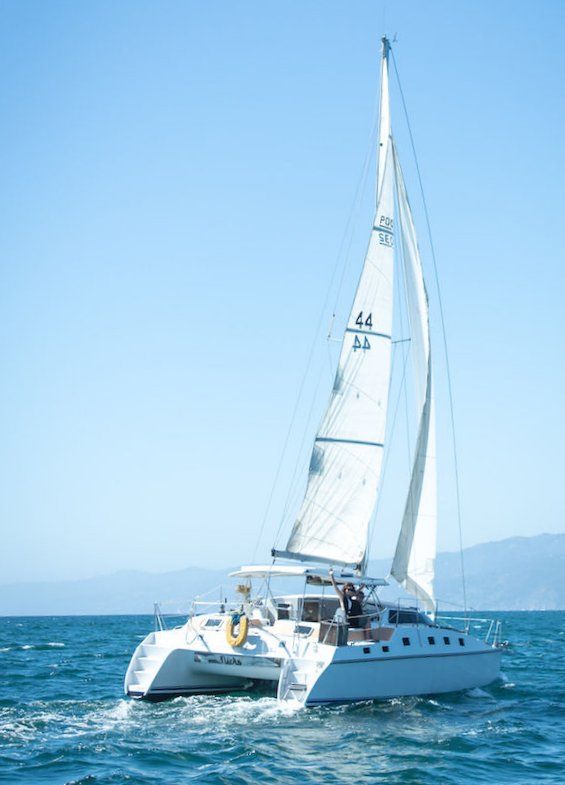
If you are a boat enthusiast looking to get more information on specs, built, make, etc. of different boats, then here is a complete review of PDQ 32. Built by PDQ Yachts (CAN) and designed by Steve Killing, the boat was first built in 1995. It has a hull type of Catamaran Twin Keel and LOA is 9.63. Its sail area/displacement ratio 21.44. Its auxiliary power tank, manufactured by undefined, runs on Outboard.
PDQ 32 has retained its value as a result of superior building, a solid reputation, and a devoted owner base. Read on to find out more about PDQ 32 and decide if it is a fit for your boating needs.
Boat Information
Boat specifications, sail boat calculation, rig and sail specs, auxillary power tank, accomodations, contributions, who designed the pdq 32.
PDQ 32 was designed by Steve Killing.
Who builds PDQ 32?
PDQ 32 is built by PDQ Yachts (CAN).
When was PDQ 32 first built?
PDQ 32 was first built in 1995.
How long is PDQ 32?
PDQ 32 is 9.45 m in length.
What is mast height on PDQ 32?
PDQ 32 has a mast height of 10.67 m.
Member Boats at HarborMoor

- Featured Listings
- Beneteau Sailboats
- Excess Catamarans
- Powerboat Listings
- Sailboat Listings
- Catamaran Listings
- Recent Price Drop
- See All Team Members
- Why Hire Team Murray Yacht Sales
- Your Saved Searches
- Ask a Question
PDQ 32 Reviews and more

Practical Sailor The PDQ 32: A Comfortable Cruising Cat Fast and full of unique features, the PDQ 32 continues to impress.
Published:September 16, 2015Updated:March 2, 20200
PDQ Yachts in Whitby, Ontario, Canada, launched the Alan Slater-designed PDQ 32 catamaran in 1994 and built 53 of the boats in the following eight years. Practical Sailor first reviewed the PDQ 32 catamaran in April 1997, which happened to be when the test boat for this review update rolled off the production line. Heres a look at what testers have learned from coastal cruising this boat for 18 years and from other owners who live aboard.
The PDQ 32 has proven to be a high-quality boat-bashing through rough seas without a groan-with bulletproof basics. It remains pretty darn quick (PDQ), outpacing much larger boats, and most PDQ 32s today sell for what they cost 15 to 20 years ago ($85,000 to $110,000).
The Design The PDQ 32 was kept lightweight- 7,200-pound displacement-through efficient design and the smart use of triaxial cloth, acrylic modified epoxy resin (AME 5000), Klegecell core, and even carbon fiber (in the main beam). As a general rule, fast cats have displacement-to-length (D/L) ratios between 50 and 70, and slow cruisers about 100 to 120. With a D/L ratio of 108, the PDQ 32 could be on the slow side, but the D/L doesnt tell the entire story.
Its sail area-to-displacement (SA/D) ratio of 19 indicates ample power to drive the hulls; the SA/D increases to 23 with the addition of a genoa. The beam-to-length ratio is 0.52, meaning length overall is nearly twice the beam. While some catamarans, such as the Lagoon 37 (0.60 beam to length ratio) come in much higher, this is a compromise. Ratios greater than 0.5 can lead to bow-burying and increased dockage rates.
Cruising World PDQ 32 This small cruising catamaran is bigger than you may think.
By Quentin Warren November 2, 2001
In the world of cruising catamarans, aesthetics take a hit when you cut down on length overall. At issue are a host of conflicting themes — the practical demand for interior volume works against the visual imperative that freeboard be low; the need for bridge deck clearance and standing headroom pushes the cabin profile skyward. What’s graceful, extended and cunning at 45 feet often becomes ungainly in the context of 35.
Which is why Alan Slater’s PDQ 32 is such a remarkable boat. Fully outfitted for long-range cruising, she remains bright, airy and easy to look at. With a nicely proportioned rig and a subtle sloping cabin top, she carries herself like a longer cat and avoids the pitfalls of many of her peers that attempt to consolidate as much mass as possible into a length that won’t accept it. You can cruise or even live aboard this boat quite comfortably, but her scale is such that sail handling and overall maintenance remain uncomplicated.
The deck is safe underfoot with wide gangways, extra-high lifelines, six sets of stainless handholds and the calculated omission of abrupt jogs or steep transitions to throw you off balance. There are deck lockers for anchoring paraphernalia in the bows port and starboard, and a very secure trampoline strung forward of the cabin between the two hulls. Open-air lounging is relegated to this area, also to the cabin top around the mast step and to the stern sections where boarding steps are molded into the transoms.The cockpit is smallish and deep, well protected from the elements by a rigid Bimini. Given its depth it offers a secure haven for kids, and with the main companionway hatch that stretches clear across the cabin shoved forward it becomes a pleasant extension of the saloon. The Bimini is strong enough to stand on when tending the mainsail, and cut-outs allow you to look aloft from the helm under way to check on trim. Care should be taken to avoid bumping one’s head on it when entering or exiting the cockpit area.
The PDQ 32: A Comfortable Cruising Cat
Boats.com Perry Design Review: PDQ 32 Headroom and volume combine to make this cat a comfortable cruiser
By Bob PerryAugust 25, 2000 The first thing you need to be aware of when checking out the design of a catamaran is that the profile and sail plan drawings are deceptive. The next thing you should focus on is that interior volumes come in odd components compared to monohulls.
The PDQ 32, designed by Steve Killing, is a small cruising cat and an excellent example of the volumetric diversity in cats. Essentially what you have in a small cruising cat is two tubes or tunnels – the hulls – connected by a big flat box, the main cabin. I call this the bridgedeck. Laying out the bridgedeck is no problem. The problem is extending the headroom athwartships to give you comfortable access down into the hulls without stooping. The PDQ accomplishes this by layering the cabintrunk in two levels, one to provide bridgedeck headroom clearance, and the other to get headroom in the hulls. There is no monohull equivalent to this design challenge.
The bridgedeck area of the 32 gives you a big dinette. When you drop down into the hulls, you have a galley to starboard with a front-loading reefer forward and the navigation station and head to port. Narrow, slab-sided hulls with minimal cabin sole areas make the layout tricky but effective. The sleeping areas are two mirror-image staterooms aft with athwartships berths.
Just for fun compare this layout to that of the Feeling 326. The boats are about the same LOA and have comparable displacements. Which one has the most useable interior? I can’t provide that answer for you, it’s purely subjective. Based upon the objective area — area of cabin sole, size of berths and counter space — I think the PDQ would win. Although, if you check the galley counter area of the PDQ, it’s so narrow that all a cook could do is line up hot dogs end to end. The bottom line is, there is more useable volume in the cat.
We know now that most cruising cats have about as much boat speed potential as LOA-equivalent monohull competitors. I don’t think you would buy a cruising cat like the PDQ 32 for blinding boat speed. The D/L ratio of the PDQ is 107.9. This is on the heavy side for a cat but indicative of the cruising nature of this design. What you are buying in a modern cruising cat is accommodations, deck space and a minimal heel angle.
https://www.boats.com/reviews/perry-design-review-pdq-32/
Canadian Yachting PDQ 32 Nov2By Steve Killing
Boatbuilder Simon Slater and his designer-father, Alan, are making a significant impact on the multihull industry. In fact, the Canadian boatbuilding industry is noticing a substantial contribution from multihulls that wouldn’t even have Been considered possible 15 years ago. Last month I toured through the PDQ plant and was treated to a sight I haven’t seen in Canada for quite a while-a real production line firing boats out the door to waiting customers! Not only were all the PDQ 32s (and their big sisters, the 36s) sold, but the shop is booked solid for the next six months.
The boat you see here is not radically different from other cats–it’s not even particularly inexpensive. So why is it selling so well?
Like most success stories in the marine industry, it is simply a carefully thought out, well-marketed boat. This combination, linked to a devalued Canadian dollar, secured nine new owners at the Miami boats show–a rare event in anyoneís books.
The original design brief to Alan was simple: create a 32-footer that keeps the performance lineage of the PDQ 36, loses little in interior space, but a lot in expense. For a while the folks at PDQ were concerned that if the project was a success the demand for the larger cat might disappear. It did wane initially, but orders for the 36 are back up again.
The most significant change in layout from their first cat (the PDQ 36) is the switch to an aft-cabin version. The deck raises aft and provides room for two 6 ft. 6 in. by 4 ft. 6 in. berths. Although all boats involve compromises, the key is knowing what not to compromise. Slater has kept the berths large and has ensured that two couples will have private cabins. The starboard hull houses the chart table and electrical panel, with a head forward. On the port side, the galley monopolizes the forward space and includes a real refrigerator like you might find in a trailer home.
https://www.canadianyachting.ca/boat-reviews/sail/1791-pdq-32-sail-boat-review
PDQ 32 Review Review by Charles K. Chiodi, Multihulls Magazine March/April 1995.
With the sun slowly setting behind the skyline of Miami, the wind was dying, the telltales on the PDQ 32 we were about to test had a hard time staying in the horizontal in the orange glow reflecting from the clouds.
Nightfall came quickly as the sun dipped behind the Herald’s building and the lights of Miami Beach started to reflect on the waterfront. From the shadows of the tiny island, hardly big enough to hoist a memorial statue, came the outline of another catamaran, also on a test run, perhaps for potential buyers. This was Miami Boat Show time, and the skippers were hard put to prove all the claims the salesmen made during the day.
Each morning and evening the show boats were let out of the corral when part of the docks were opened for demo rides and media inspection. The press mingled with potential buyers and listened to the dreams which they had come with, and the realization of facts they had learned during the day. They weren’t too far apart, for most wanna-be skippers were surprisingly educated about multihulls. It was no longer a question of “should we switch to a catamaran” but rather “which one?”
Those on the PDQ 32 were already familiar with their design and the company that builds it through MM and other sources, it was just a matter of the “three-dimensional experience” – the final convincer. All of us aboard were aware of the lively nature of this newest breed from Alan Slater’s drawing board, we just wanted to experience it. Thus it was not surprising that those of us on the wheel and winches were eager to keep distance between the PDQ 32 and the shadow of that catamaran that seemed to get a bit larger as time went by. It was too dark by now to identify it from the distance; all we knew was that we had to keep this cat going so as not to loose face by being overtaken. No, we were not racing, just, just… well, you know how it is when two boats are sailing in the same direction. It is more prominent when the company president, all his salesmen, a few potential buyers and the press is aboard. Of course, the same could well be the case on that other catamaran… all right, so we were racing, mentally.
After about half an hour or so, the other cat caught up with us. It was the Catalina 411, no match for a 32 footer. The relief was bittersweet.
Being at the helm, I kept asking for local knowledge, for not being familiar with the area, the last thing I wanted to do is run aground or hit a finger pier in somebody’s back yard in the dark. I was assured of plenty of water (she only needs little more than three feet), and it was quite daring (in my opinion) how close we came to those docks in the dark, before we tacked. It may have been a bit of bravado to show everyone the virtues of the PDQ 32, but just a small turn of the wheel accomplished a beautiful and very efficient “about face” – and we were shooting off in another direction. I am sure the self-tacking jib, with its curved track in front of the mast, had something to do with it. The tack of the jib is attached to an aluminum beam, as is the forestay, instead of the usual bridal seen on some other catamarans. This assures a better leading edge and a more efficient foresail which, too, accounts for easier tacking.
By the way, we never touched anyone’s dock (although I thought we could have if I had leaned out far enough). Naaaaw… it just seemed so in the dark.
The wind, if you could call it that, was never more than five knots, mostly less, but the cat moved nicely at about 3-4 knots with eight people aboard. This may not be the speed you get in the same wind when you have a full tank of water and fuel, your bilge is your wine cellar, and your provisions on board are ample for a months cruise. I don’t know how pretty damn quick this 32-footer would move then, but I sure would love to find out. (Shucks, I don’t have a spare month).
Going below deck is easy when the 10-foot wide sliding hatch is open, you better duck if it is not.
The saloon is richly appointed, light and airy with a panoramic view. The dining room table converts to a double berth. The hulls also have a double berth athwartship in the aft quarter, the starboard side being the owner’s cabin with more space and storage than the one in the port hull. Also in the starboard hull, amidships, is a spacious navigation station and more storage. Up forward are the head and shower with sump pump.
The port hull has the galley, large by 32-footer standards, with a double burner stove, oven, double sink with pressure water, and a 4-cubic-foot propane/110 volt refrigerator.
There are plenty of hatches and opening ports to provide adequate ventilation, even in southern climates – a very thoughtful feature from a builder who is frozen and snowed in a good portion of the year.
Power is provided by twin 4-stroke Yamaha 9.9 hp outboards, widely spaced under cockpit seats, assuring a turning radius within the boat’s length. They provide approximately 7 knots of speed, depending on sea conditions.
The cockpit is deeper than any of the catamarans I ever sailed on. In bad weather it will give you a very secure (and cozy) feeling. A high chair (not the children’s kind) provides the helmsman with the ability to see above the cabin top. Those on the benches are out of luck looking forward. A hard top over the sliding hatch and a good portion of the cockpit is a godsend in rain or under scorching sun alike. It has two skylights for checking the set of the mainsail. Steps incorporated into the transom and a swim ladder on the starboard side make getting in and out of the water easy.
Both hulls have fin keels for better lateral resistance, and are built with a sacrificial section to protect the hulls in case of accidental grounding or collision with stubborn flotsam.
For those who need to know the ingredients: the hulls are built with triaxial glass and AME 5000 resin, solid below the waterline, Klegecell foam sandwich above. The main crossbeams are reinforced with carbon fiber, the forward beam is aluminum with a gull-striker. The jib is self-tending, the mainsail is fully battened, the mast is a simple extrusion with a single diamond stay.
I predict that the PDQ 32 will be a success, like her big sister, the 36, not only because it is a good, no-nonsense design, but also because it is built by people who are conscientious, honest, and good at what they are doing. If you want to check it out, ask Simon Slater – or anyone at PDQ Yachts – to show you around.
A PDQ 32 Passage Mice Will Play: Passagemaker and Cruiser by Brian Murphy, Ottawa, Canada
My first step outside the Ft. Myers airport left me wishing I’d brought more warm clothes along, a feeling that would stay with me over the next few days. I had just arrived from Ottawa to help deliver a new PDQ 32 from the boat show in St. Petersburg to a charter company in the Bahamas. It was November in Florida, but it felt like October in Canada.
The plane was delayed just enough that the departure of Mice Will Play, a brand new PDQ 32 from Cape Coral, had to be delayed until the morning. The boat had arrived in St. Petersberg a few days earlier for the boat show. We performed our provisioning and made a few last minute phone calls and adjustments.
I have sailed the PDQ 36 on several occasions but this was to be my first visit aboard the 32. My first impression of the cockpit was that it was a touch closed in when compared to the larger 36. However, I was soon to fall in love with the more protected feeling and comfort of the hardtop bimini and wrap-around dodger.
The first day we motored all day along the St. Mary’s river at a comfortable 6.7 knots (although speed over ground was less due to the small current flowing from Lake Okechobee to the Gulf of Mexico). The on-deck speakers were able to match the drone of the engines. At 50 degrees the dodger gave great protection from the wind and elements and almost made up for my lack of warm clothing. Little did I know at that time that the green grass I had left in Ottawa had been covered in three feet of snow!
The next morning we approached Lake Okechobee. The St. Mary’s River enters and exits the lake at the middle of the oval lake. A canal system provides a route along the southern shore due to the shallowness of the lake. We planned to go most of the way south and then follow the channel into the lake. This would be safe but also promised to be a tad uncomfortable as we would have to go straight up the lake into a strong norther. After motoring for about a couple of hours, we came around a corner and the canal emptied out into the lake — there was nothing in sight. No buoys, no buildings, no nothing. We quickly checked the GPS and found that we had missed a right hand turn and ended up in an old channel which had not been in use since the 1970s. The moment of truth was upon us. We could either motor back down the canal and return to course adding an hour or more to the passage, or grasp the serendipity of the moment and head straight across the lake. The chart indicated about three or four feet close in to the shore but the depth indicated closer to six feet.
After some careful considering of the charts and nosing around in the shallow water, we decided that the 3′ draft was up for it and I headed forward to raise the main. There was a strong norther (hence the cool weather) blowing raising about three foot seas. As I hung on for dear life I fondly recalled this procedure on the 36 where all halyards lead to the cockpit. It turns out that the chop was about the same length of the boat and so made the motion particularly severe until underway. We watched as the depth gradually increased to about 16 feet, about the deepest you will find this shallow lake.
We flew, as the proverbial crow would, directly across the lake approaching close hauled. Rather than the tiring beating at a 20 degrees of heel we were warm in the protected cockpit and no heel at all. We managed to shave several hours off the trip and got an exciting sail in as well. We arrived at Stuart at 3:30 in the afternoon after getting a tail current on the way back down to the Atlantic Ocean. We had thought it might be after dark when we would arrive – and on a slower boat with deep draft we would have been.
We spent a day in Stuart installing a few new-boat amenities such as garbage cans, hook holders, extra glasses, and so forth. We picked up an extra crew member for the crossing of the Gulf stream and got the laundry done, a boat full of provisions and a restaurant meal on board. We only half filled the storage lockers under the settee with gallons of cheap beverages which were extremely expensive in the Bahamas. In fact we never came close to using up the vast locker space available.
At 4:00 that afternoon we set out for the Ocean. It quickly got very dark and we picked our way out to the intersection of the St. Lucie River and the intercostal waterway. From there we made for the Port St. Lucie outlet. The outlet is one of the more spectacularly unmarked channels out of the intercostal. The shifting sands at outlets lead the buoy placers and chartmakers to virtually abandon the area. With no depths on the chart, no buoys, and traffic with bright headlights bearing down on us we picked our way to the sea. We missed the sea walls and breakwaters as well as a few large tankers in the shipping lanes. Again I was happy of the three foot draft as there were more than a couple of spots where even a four foot keel would have given us trouble.
A beautiful night to cross the Ocean. The water temperature was about 72 degrees, the wind moderate, about a three foot sea and nothing but stars above. As we got several hours off shore the water temperature surged to 82 degrees and the seas heightened to about five feet — we were in the gulf stream. I stood a four hour watch steering due east and heading for Orion’s belt. The lights of the gold coast seemed like a permanent twilight which did not fade until we had reached the Bahamas.
At 12:00, my shift over, I headed below for a nap and what a nap it was. The aft location gives a gentle rolling motion and not the hard slapping which can occur with bunks foreword. Three hours later it was up again. Just as first light appeared in the east, the Bahama Banks were coming into view on the horizon. We sailed all day in about 12 feet of water and finally reached Sale Key by 4:00pm. We had covered about 170 miles in 24 hours.
The following day we made for Green Turtle Cay to clear Customs and register the vessel in the Bahamas where it would be staying in charter. We arrived just after the Customs officer had taken the last ferry for Nassau and would not be back for the rest of the day. So we headed in to get some gas while flying our quarantine flag. The water in the Bahamas can be very thin. The most difficult thing is to be able to recognize when it really IS thin and when it just looks thin to the eye – an eye which is used to brown water lakes. This distinction eluded the watchperson we had placed on the nets and Mice Will Play proceeded to run onto a coral head whilst heading for the gas docks. However a quick shot of reverse pulled us off the reef and a later inspection showed no damage at all (except for the slight scratch to the antifouling paint).
Off to Marsh Harbor where we finally contacted a Customs agent and were now able to step ashore. All in all a good crossing. We had been working 11 hour days or more for a week and it was time for some relaxation. We dropped off our friend at the airport and were joined by our wives to enjoy the cruising portion of the sailing trip. From passagemaking to relaxation, the PDQ 32 made the transition.
As we leisurely sailed to Little Harbor, Great Guana Cay, Harbour Town, Man-o-War Cay we spent less time in the cockpit, (it had finally warmed up) and more time out on the trampoline and the excellent bench seat right behind it. There was so much room that four people never felt close.
I have fallen in love with the PDQ 32. It felt solid, safe and seaworthy with good speed for passagemaking. It lacks some of the speed of the 36-footer but tends to make up for it in the comfort of the cockpit (a more aggressive sail plan might help). The yacht was comfortable, spacious, fun and good looking — just great for cruising. It is really all the little things that add up the total quality impression of the PDQ.
These boatmakers obviously think about cruising all the time — both in cold and warm weather. For example, the floor was incredibly easy to clean-up and the no-slip rubberized surface made great sense and looked good (if you have ever stepped on a teak and holly floor with slippery wet seawater feet you’ll know what I mean). Also, think how much damage sand can cause to a wooden floor. We also had occasion to suspect the water pump had failed and proceeded to try to find it, wrestle it out of its hiding place and attempt an inspection if not repair. Armed to the teeth with tools we were quickly delighted by the cleverness of the device and its neat installation. It was easily accessible from two angles, the wires were connected using easily unpluggable sockets, and the actual pump lifted out of a mounting bracket without the use of screwdrivers. The leak turned out to have been crew error and not the pump at all. All these little things add up after you have been cruising for a few weeks.
- Pingback: Catamaran & Multihull Reviews
Comments are closed.
PDQ 32 vs PDQ 36
- June 29, 2015
I suspect it is fairly common thinking that a larger boat is better than a smaller one. This is probably justified in many cases as it seems as if manufactures often begin by building smaller yachts and then as time goes on, increase their designs in size. That was not exactly the case with PDQ Yachts though. The original PDQ cat, a 34′ model, was introduced in 1987. This was eventually lengthened to 36′ and was very popular. In 1994, PDQ introduced a second design, a 32′ long model. While shorter in length, the newer yacht had both a higher bridge deck clearance ( the distance from the surface of the water to the underside of the boat ), and higher freeboard ( the distance from the water’s surface to deck level ). In fact, if you look at the image below which shows ZTC on the left rafted up to a PDQ 36 on the right, it almost appears as if our PDQ 32 is the larger boat!
Which boat looks larger?
Rebecca and I had a real treat the last few days. We had the opportunity to spend some time with David Slater , the son of Alan Slater , PDQ’s chief engineer and designer. David shared his thoughts on the catamaran’s designs. He explained that when PDQ Yachts first introduced the 34/36, they had no idea that the catamaran owners would load so much “ stuff ” onto their boats. When they designed the newer model, keeping in mind what they had learned from their initial offering, they began with the bridge deck clearance that they wanted and then went from there. In his words, completely unsolicited, the 32 is really a better boat for cruising the tropics! Obviously, we are biased but, having been on board both models, we tend to agree. And we’re not the only ones. ZTC’s previous owner told us that when they were shopping for a cat, they looked at both the 32 and the 36 and chose the slightly shorter boat as they felt that is was a better design. Food for thought if you’re looking to purchase an awesome small catamaran!
Sailing yesterday with David Slater and friends from LTD Sailing .
Related Posts
We are tied to the ocean.
- November 16, 2016
- January 1, 2011
It’s hard being an amateur
- August 6, 2011
Itchy and scratchy!
- September 21, 2013
Hi Mike, We’re not quite ready for moving to grenada but if you can deliver to florida or bahamas we might make a deal. Brian
Hi Brian. A delivery skipper can do that trip in 10 days. I happen to know two professionals who do trips like that for a living. Contact me by email if you’d like to make an offer.
There are 3 things about the 32 that I find delightful in warm weather:
* With the slider open the salon and cockpit become one. * The all-around view from the salon is delightful. Sailing is an outdoor activity–you shouldn’t live in a cave. * Since the tramp is high enough above the water to be dry in fair weather, it is often the best seat in the house; it has put a lot of guests to sleep while underway!
Excellent points! I love all of those things.
I don’t think you could go wrong with either the PDQ 36 or PDQ 32 s they are quality built catamarans. We owned a 36’er and have been on a few 32’ers and they both have their pros and cons. We decided on the PDQ 36 as the extra length and beam meant for a more seakindly motion. We also liked the ventilation that the 36’er has over the bunks which is unmatched by any catamaran that we have owned. Given that, we have always been jealous of the bridgedeck clearance of the PDQ32 and the fact it would take less $’s and time to maintain. Did you ask David why he chose the PDQ 36 as his personal vessel? He seems to have it really tricked out with daggerboard’s etc. I hope he’s enjoying his new Outremer 45!
I agree AJ. I’m sure we’d be pretty happy on a 36 too!
While I haven’t seen it, it sounds as if David’s 36 is pretty unlike most of the other. As you mentioned, it has daggerboards. He also said that it has no stanchions and lifelines. Sounds as if it’s pretty tricked out for racing, or at least sailing fast.
I think he likes the Outremer too. That is what we were sailing on this past Sunday.
Comments are closed.
- Bikes and Gear
- Posts by Rebecca
- Boating Links – Books, Blogs and More
- Cycling Links – Books, Blogs and More
- Shop Amazon
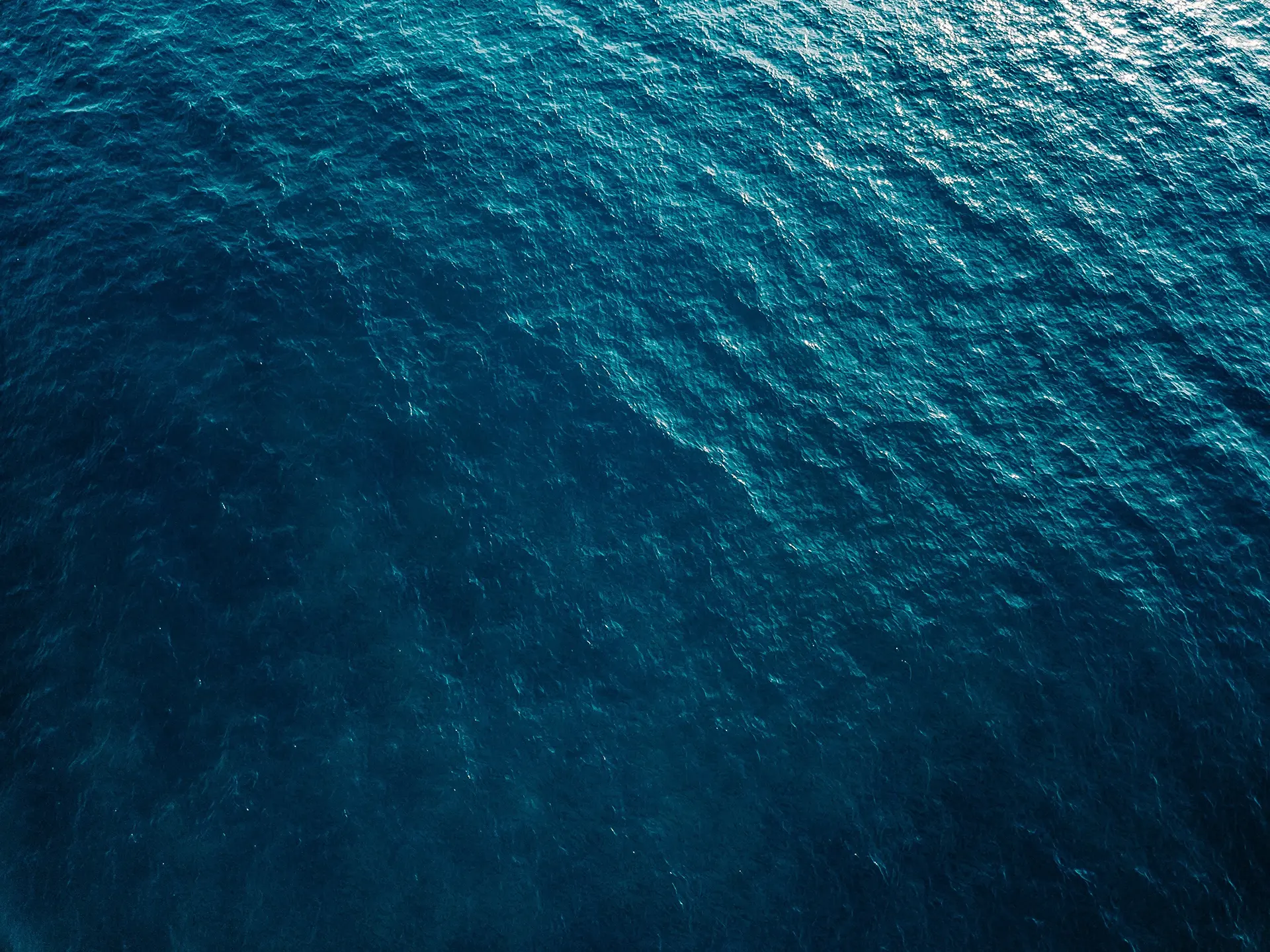
Specifications
Basic information.
- Builder PDQ
- Model Altair LRC
- Category Catamaran
- HIN/IMO QPQ32036E898
- Condition Used
- Fuel Type Diesel
- Hull Material Fiberglass
- LOA 31' 7"
- Beam 16'
- Max Draft 3' 2"
- Fuel Tank 55 GAL
- Fresh Water 74 GAL
- Holding Tank 25 GAL
- Displacement 7,200 LBS
- Number of Engines 2
- Make Yanmar
- Model 2GM20
- Power HP 20.00 HP

"Mongoose Magic" 1998 PDQ 32'

32' PDQ Altair LRC 1998 located in Solomons, MD. This Long Range Cruiser has twin Yanmar diesels, additional water storage, windlass, Inverter, refrigeration, davits, Caribe dinghy with Yamaha engine, full cockpit enclosure etc. She is well equipped for cruising and all her equipment including galle
Full Description
Accommodations
- When entering the salon from the cockpit one is greeted by the large U-shaped dinette that can easily accommodate 6 for dining and offers a panoramic view as well as a hi/low table to convert the dinette to an additional berth. Her sliding cabin top allows plenty of headroom in the aft area of the salon and walkway to either side hulls. The port hull has the galley and aft stateroom. The starboard hull has the forward head, navigation station and aft stateroom. Both staterooms are identical in size and comfort with honest doubles that can use the same bed linen you would choose for your home. Owner upgraded the berths with an additional 6" mattress's.Overhead hatches
- Table with 2 drop leaves
- Under seat storage
- Interior wood trim is Cherry
Starboard side aft;
- Large standard size double berth
- Twin reading lights
- Overhead light in each stateroom
- Storagew under the bunk
- Hanging locker
- Clothes lockers
- Dressing seat
- 12-volt fan
Midships to starboard:
- Navigation station with flip up table
- Table and chart storage
- Marine AM/FM/Satellite stereo CD player with two saloon speakers and two cockpit speakers
Forward to starboard is the head;
- Electric flushing toilet
- Dual control hot and cold fresh water top
- Hot and cold pressurized fresh water shower
- Shower sump with dedicated pump
- Medicine cabinet
Aft port cabin;
- Large standard size double bunk
- Storage under the bunk
- 12-volt fans
Midships and to port is the galley featuring;
- 2 Burner propane stove
- Microwave oven
- Hot water heater (electric with engine heat exchanger)
- 5.5 cubic ft top loading reefer/freezer
- 12 Volt refrigeration system
Deck and hull
- Inter-protect 2000 Epoxy barrier coat
- Water tight compartments in each hull
- White gelcoat topsides
- Blue boot stripe
- Composite rub rail with stainless steel bull nose cap port and starboard
- Stainless steel striker plates port and starboard bows with upper D-ring
- Swim ladder starboard transom
- Stainless steel hand rails on port and starboard transom
- Stainless steel dinghy davits
- Hot and cold transom shower
- Skegged rudder
- Tank Watch for holding tank
- Folding prop
- Starting from the transoms and moving forward one steps aboard via the three molded in transom steps. The aft deck features;Stainless steel pushpit with twin wired gates port and starboard
- Lifesling mounted on pushpit
- Barbeque grill on pushpit
- Dinghy davits
- Hard bottom Caribe inflatable with Yamaha outboard
- Twin lockers
- Main-sheet traveler
- Aluminum framed deck hatches port and starboard for the aft cabins
- Stern cleats port and starboard
Moving to the center of the aft deck there is a molded companionway giving easy access to the cockpit under the hard bimini. Here one will find;
- Stainless steel hand rails on the hard top port and starboard
- Solar panels
- Overhead hatch in hard top
- Clear plastic windows wrapping around the forward portion of the hard top
- Full cockpit plastic enclosure
- Full cockpit screens
- Stainless steel destroyer type helm
- Fire extinguisher
- Engine panels and throttles
Electronics
- High volume pump
- Molded helm seat with cushion
- Molded seating around cockpit
- Locker access to battery bank
- Engines port and starboard with access under the berths
- Outlet for shore power
- Acrylic swing out door to salon with lock
Leaving the cockpit and moving forward along the side decks;
- Stainless steel hand rails outboard on deck port and starboard
- External chain plating port and starboard
- Stainless steel stanchions with double sire life lines
- Mid ships cleat port and starboard
- Dual anchors, anchor chain, rode and electric windlass
On the coach roof above the salon there is a wrap around acrylic fixed port light that offers exceptional light and visibility to the salon.
- Turtle for overhead sliding hatch in salon
- Aluminum framed deck hatches port and starboard
Continuing forward from the coach roof is the fore decks that are separated by double trampolines (they have been replaced).
- Pulpits port and starboard
- Single wire safety line between port and starboard pulpits
- Bow cleats port and starboard
- Anchor rollers port and starboard
Sails and Rigging
- Aluminum deck stepped mast supported by internal compression post
- Hood roller furling for the headsail
- Adjustable topping lift
- Over and under turning blocks with 4 blocks port and starboard
- Jib traveler
- Harken #32 two-speed self0tailing primary winches
- Harken #16 one-speed self-tailing secondary winches
- 4 side by side rope clutches port and starboard
- Winch handle pockets port and starboard
- Fully battened mainsail with two sets of reef points and single line reefing with Lazy Jacks
- Self-tending jib with UV protection
- Gennaker with ATN tacker
- All lines are led aft to the cockpit for ease in single handing
- Garmin Map Plotter
- Autohelm ST50 Tridata (speed, deth temp)
- Autohelm ST 50 wind meter
- Autohelm ST 4000 autopilot
- Horizon Eclipse Marine VHF radio
- Ritchie Compass
Electrical System
- 12 volt DC panel with voltage and amp meter
- (4) golf cart batteries
- Solar panel
- Heart Freedom Inverter/charger for 110 volt power while anchored
- 110 volt panel with voltage and amp meter
- 30 amp shore power
- 30 amp 30' shore power cord
- 110 volt power outlet with GFI plugs
- Pre-wired and plumb for water maker
The company offers the details of this vessel in good faith but cannot guarantee or warrant the accuracy of this information nor warrant the condition of the vessel. A buyer should instruct his agents, or his surveyors, to investigate such details as the buyer desires validated. This vessel is offered subject to prior sale, price change or withdrawal without notice.
32' PDQ Altair LRC 1998 located in Solomons, MD. This Long Range Cruiser has twin Yanmar diesels, additional water storage, windlass, Inverter, refrigeration, davits, Caribe dinghy with Yamaha engine, full cockpit enclosure etc. She is well equipped for cruising and all her equipment including galley gear convey. The PDQ was built in Whitby, Ontario, Canada. This is quite a clever design with two level seating in the cockpit that is covered by a hardtop and has a full enclosure making her comfortable in inclement weather. As a 32 footer they were concerned with the headroom in the salon area but designed a full width sliding top that allows headroom in the aft area of the salon. It is not needed forward as you would be sitting in the U-shaped dinette. When the hatch is closed (and it doesn't have to be often with the acrylic windows connecting the hardtop to the deck) you stoop. Headroom in the side hulls is 6'11" where the Nav station, galley, private staterooms and head are located. The hulls are solid glass below the waterline and cored with Klegecell foam above the water.This owner opted for the upgraded twin diesels. The reliability and power of the diesel inboards make them very attractive.

Share this Boat
Terrapinsailing.com
Commuter cruising on a pdq 32 catamaran.
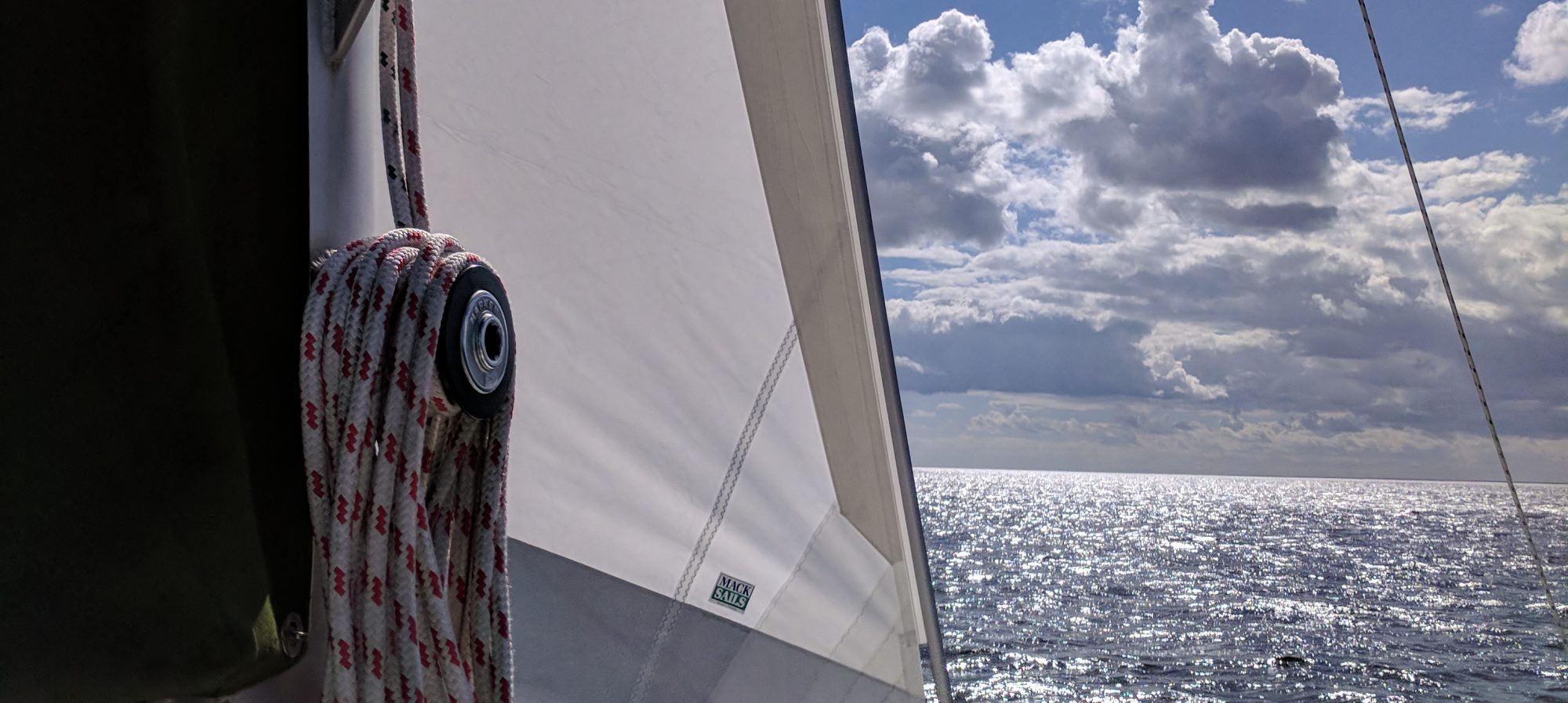
Bahamas Cruise 2023
Bahamas cruise, 3/21/23 to 5/18/23
Our first cruise to the Bahamas. We have worked hard to make Terrapin self sufficient living “off the grid” with watermaker, lithium batteries, more solar, and B&G electronics. We traveled about 1200 miles over this time and I’m happy to say that all our hard work paid off. The trip was fantastic and Terrapin and crew performed very well. We posted a lot to our Facebook page during the trip, but I failed to keep up the posting on this site. I will try to rectify that by posting some of our highlights here.
Traversing the Gulf Stream. Notice the S-shaped track. This is due to the 2-3 knot Gulf Stream carrying the boat North as we kept a due East or West heading. Leaving from North Key Largo at sunrise, we arrived in Bimini late afternoon.
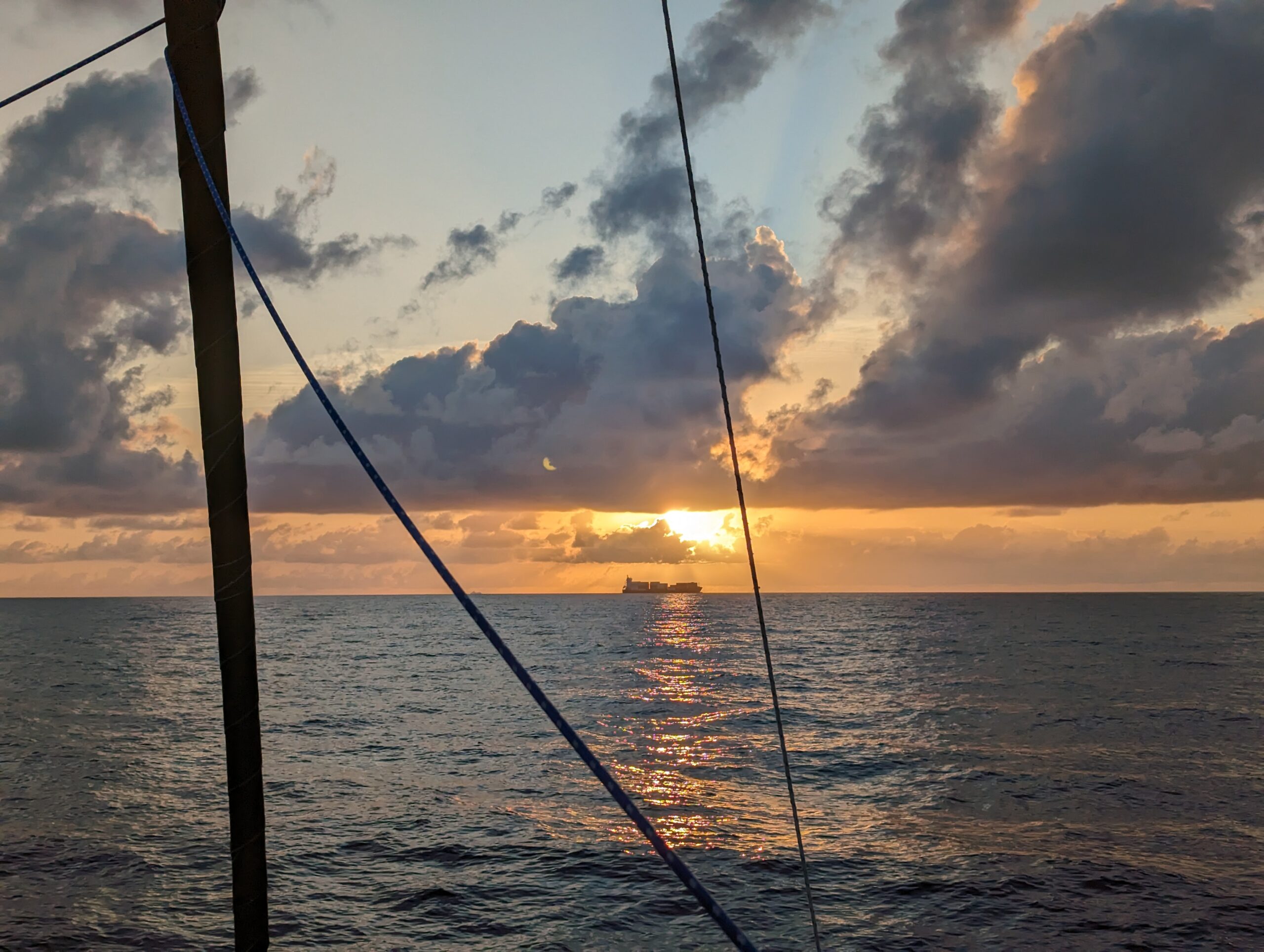
Crossing the Gulf Stream at sunrise, this cruise ship was in our way!
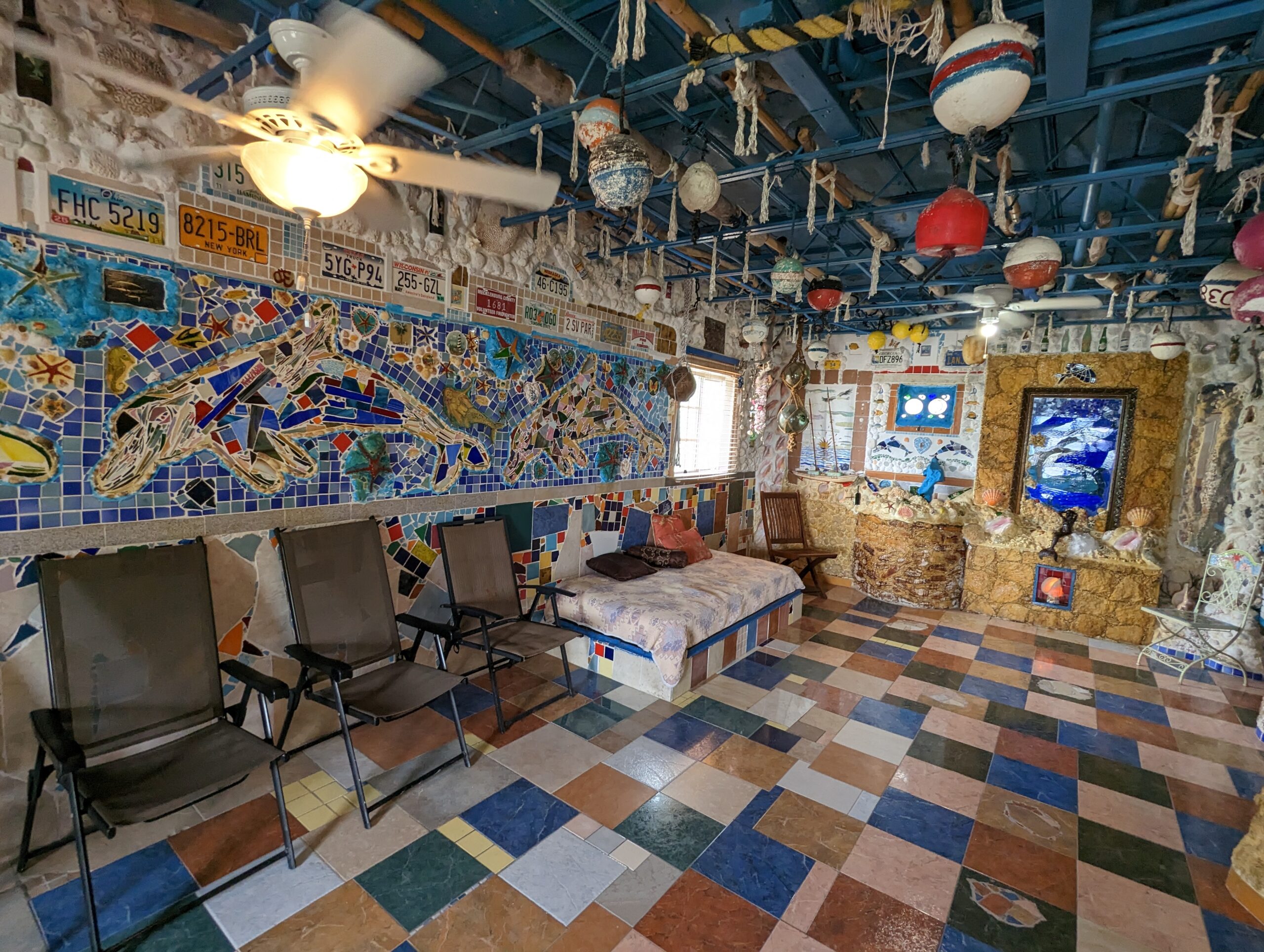
The absolute HIGHLIGHT of our visit in Bimini was the Dolphin House. It is a three story concrete building built by hand by Ashley Saunders. It is an absolute work of art.
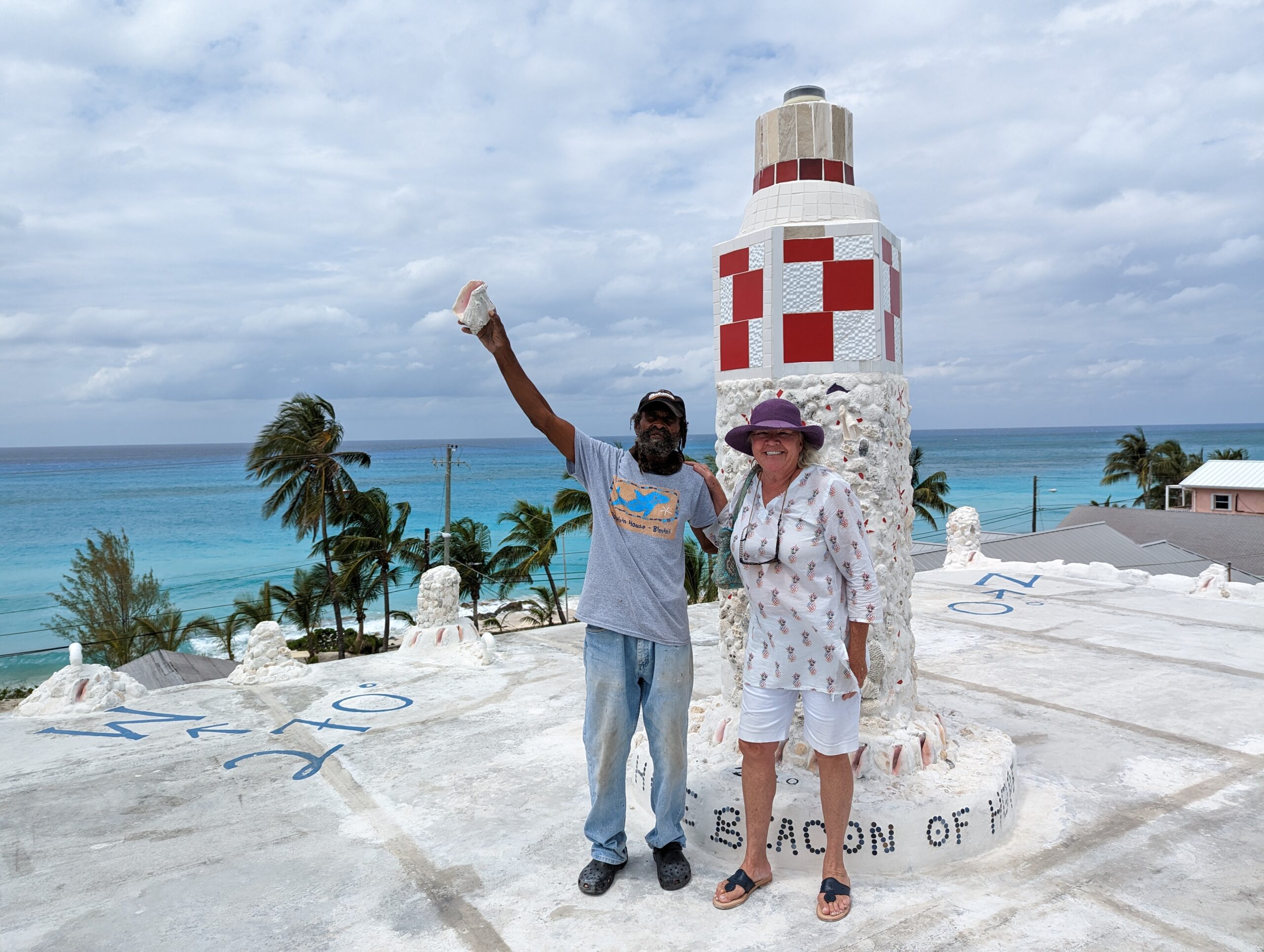
Ashley Saunders gave us a personal tour of his Dolphin House, complete with a lighthouse on the roof!
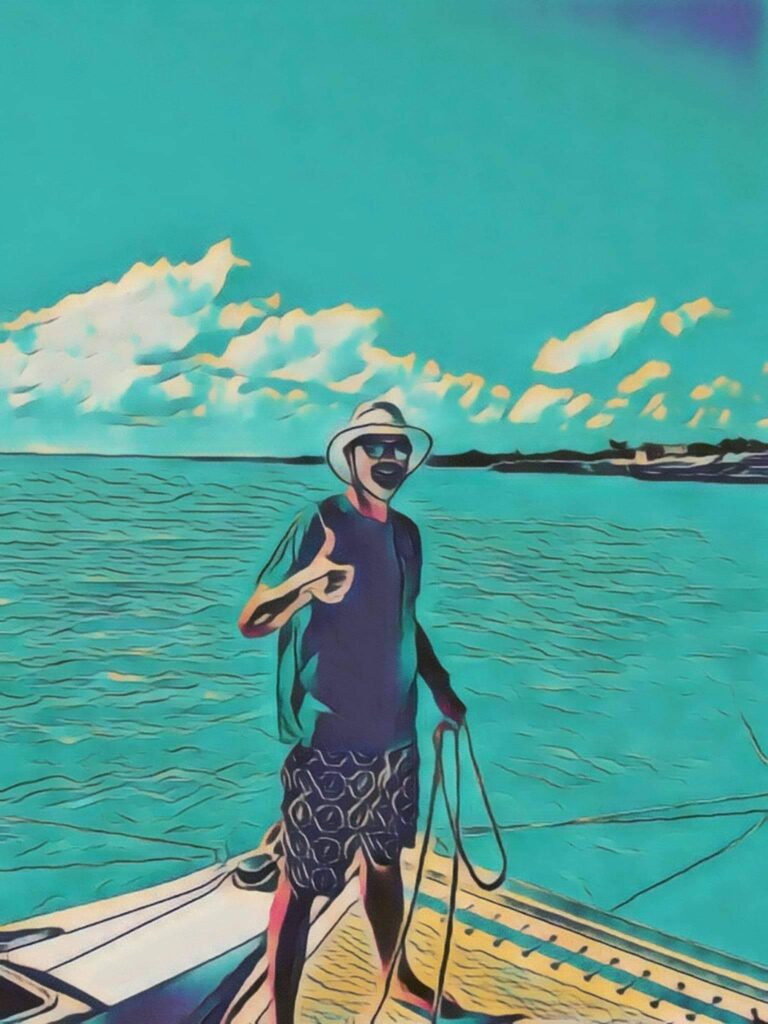
Bells Cay is a private island in the Exuma Land and Sea Park. It is owned by Aga Khan, the Muslim Spiritual Leader and philanthropist. While we couldn’t go ashore, it provides one of the best sheltered anchorages from a strong West wind which blew for 3 days.
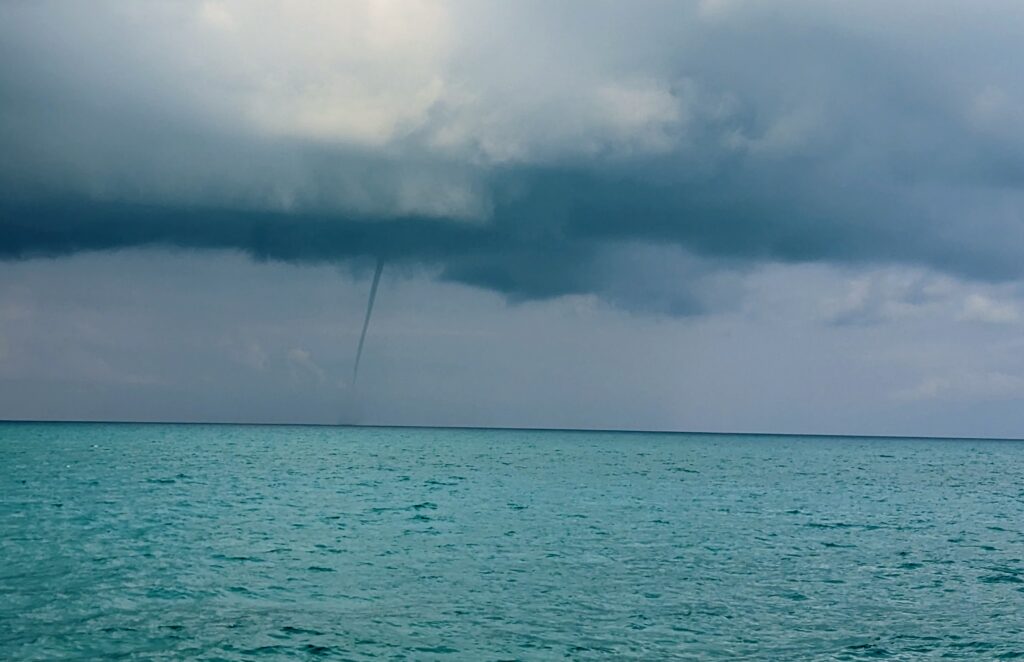
Woke up to this water spout on my birthday. Luckily, the weather improved and we cruised into Staniel Cay to celebrate my birthday.
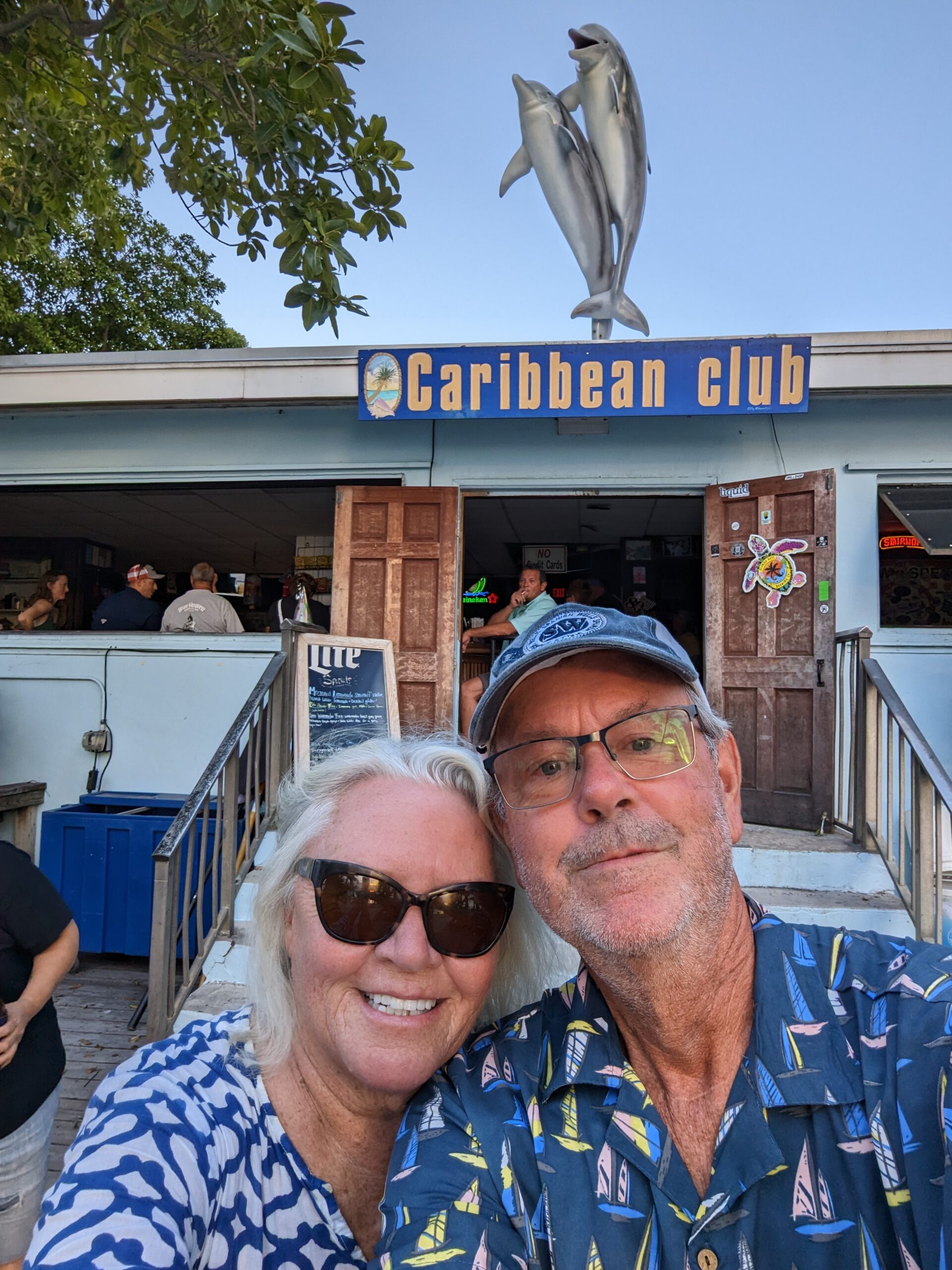
Our favorite bar in Key Largo where Bogart and Bacall stared in the movie Key Largo.
Terrapin Electronic upgrade: Part III
Otto Von Helm
Otto is our third crewman. He steers the boat for us when we are not able to take the helm, for whatever reason. Otto is a computer that receives input from various sensors and then steers the boat based on criteria set by one of the human crew. We can tell Otto to steer to a particular compass heading. We can tell Otto to follow a particular route entered into the Zeus 2 chartplotter. We can tell Otto to keep the boat at a particular angle to the wind for optimum sailing. How does Otto do this? Otto is a B&G NAC2 computer linked to the Zeus 2 MFD via the N2K backbone for the control interface, and a motor that drives the steering wheel via a belt. Otto receives a variety of data from various sensors also connected to the N2K backbone. This includes wind speed/direction, compass heading from the Precision 9 compass, and rudder angle from the rudder angle sensor.
The Precision 9 compass is the key to allowing Otto to know which direction the boat is pointing. While we have a great gimballed compass at the helm, it is not electronic and does not provide any information to Otto. The Precision 9 is a fluxgate compass (electromagnetic) that provides heading and rate-of-turn information to the N2K network for use by the autopilot, radar and other algorithms within the Zeus2. It has an internal array of solid state sensors that can measure motion and orientation on 9 axes. So Otto always knows exactly which direction the boat is headed. To maintain a particular heading, Otto sends a command to the motor to turn the wheel, which is attached by a chain/cable mechanism to the boat’s twin rudders. However, Otto also needs to know which direction the rudders are pointing: straight ahead, 10 degrees to port, or some other direction. This is accomplished by a rudder angle sensor that I installed in the stern attached to the rudder control mechanism. The rudder angle information is then sent to the N2K backbone. Finally, we can also tell Otto to keep the boat at a particular angle relative to the wind. For this, Otto uses the wind direction information provided by the wind vane at the top of the mast through the N2K network. All of this can be controlled by the autopilot function on the Zeus 2 MFD . The autopilot is an essential piece of gear for any long distance cruising. It can get very tiring manually steering a course for hours at a time, and generally Otto can do it better. This allows the helmsman to keep a better watch or attend to other things like sail trim./
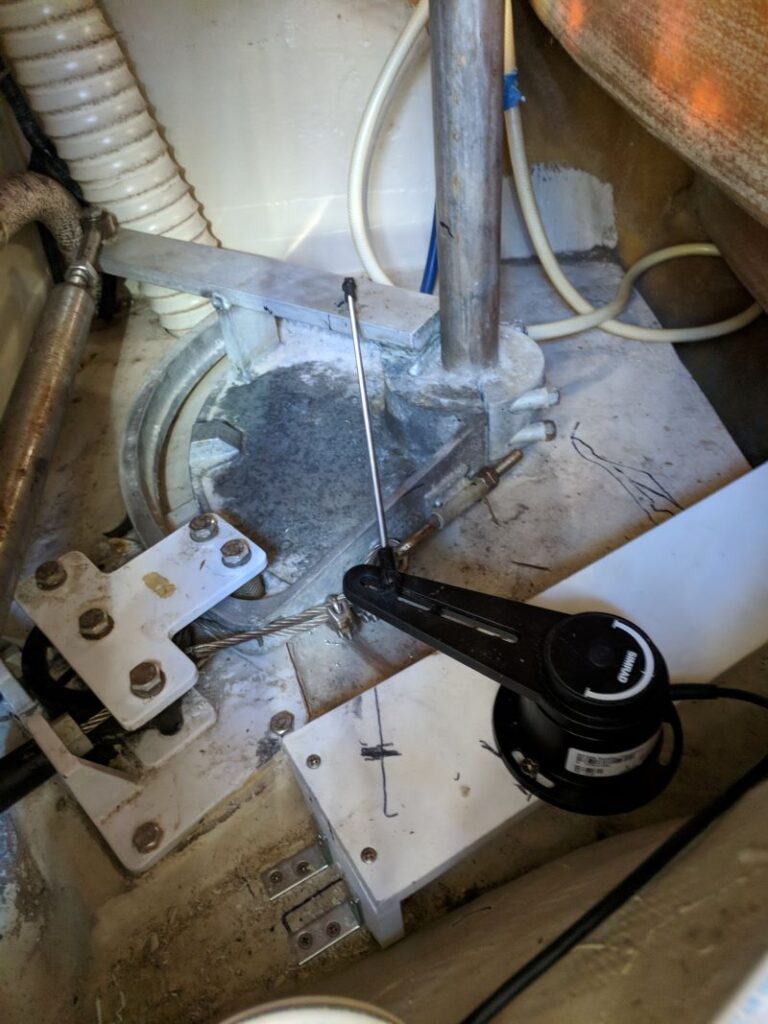
Terrapin Electronic Upgrade, Part II
I see you, do you see me?
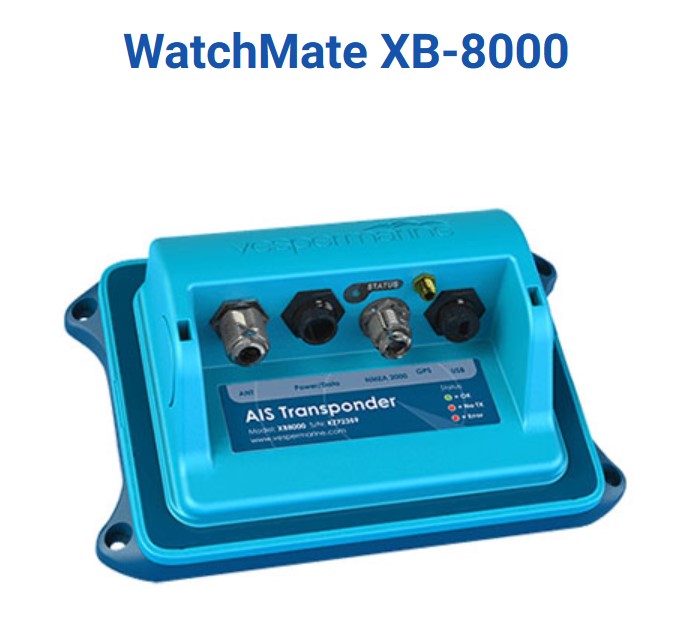
In phase 2 of my electronic system upgrade on Terrapin, I installed a Vesper XB8000 AIS transceiver. Automatic Identification System (AIS) is a means of broadcasting the location and information about a ship using VHF radio frequencies. It is used world-wide by commercial ships as well as recreational boats, and increasingly, other objects like buoys and personal locator beacons. However, there are a lot of boats that do not have an AIS transmitter, so you can’t rely on AIS to see all ships in your vicinity. It is nonetheless useful to see commercial ships and large yachts who typically broadcast AIS. If you want to see other vessels transmitting AIS, you only need a receiver, but if you want others to see you, you need a transceiver. AIS transmits vessel data such as name, size, type of vessel, speed, heading and the Maritime Mobile Service Identity number (think cell phone number for your boat). The really cool thing is that a vessel transmitting AIS data shows up as a little triangle on your chartplotter, so you can see exactly where it is relative to your own boat. If you put the cursor over the boat icon, you will see all the information about the boat. I was sold on AIS when we chartered a catamaran in the Caribbean that had AIS and I could “see” our friend’s boat from 5 miles away on the chartplotter as we rendezvoused. The AIS unit is basically a small device that can be mounted out of sight and connected to the N2K backbone with a drop cable. It also needs to be connected to a VHF antenna, preferably at the top of the mast, and an external GPS antenna. An AIS transceiver can also share the same VHF antenna as the VHF radio using a splitter. I chose the Vesper Marine AIS transceiver because it had a great reputation and it also had WiFi, so that the AIS data and N2K data could be transmitted to the WiFi system on Terrapin (See blog post How to Get WiFi on a boat ). The Vesper AIS also has a great anchor watch app that will track the location of the boat during anchoring and alert you if the boat drags anchor.
Because of the importance of GPS for an AIS system, they are designed to have a dedicated input from a GPS “mushroom” antenna located in an outside area with a clear view of the sky. The vesper came with its own GPS antenna which I mounted on the stern rail and routed the coaxial cable to the inside locker where the AIS device is located. An added benefit is that this GPS antenna became the main GPS source for the Zeus chartplotter as well. Again, this illustrates the benefit of the N2K system. Because the AIS unit is attached to N2K, the chartplotter has access to not only the AIS data, but GPS data as well. The Zeus 2 chartplotter also has it’s own GPS antenna, but it is built into the chartplotter itself which is under the solid fiberglass bimini. It works, but it is not as sensitive as the dedicated AIS GPS.
The Vesper VHF splitter is a small device that allows the use of the same mast top VHF antenna for both the VHF radio and the AIS transceiver. It is a powered unit that has several great features and is well worth the expense. It actually amplifies the AIS signal and improves the sensitivity of the AIS. It also gives the VHF radio priority and maintains an antenna connection for the VHF radio even when power to the splitter is off. The splitter also has indicator LEDs that indicate whether the AIS or the VHF is transmitting and a red LED to warn if there is a problem with the antenna circuit. Hookup was easy. I removed the VHF antenna cable from the VHF radio and attached it to the Antenna Out on the splitter. The VHF radio was then attached to the splitter “VHF IN” connector and the AIS unit was attached to the splitter via the “AIS IN” connector. The splitter than needs to be connected to a 12Vdc source, switched on the same breaker as the AIS unit itself. This is important because the AIS can be damaged if it tries to transmit without an antenna connected.
Initial configuration of the Vesper XB8000 was a little bit convoluted but not too bad if you follow the directions in the on-line manual. Basically it involves downloading a configuration utility onto a laptop or ipad and connecting to the Vesper AIS directly with a USB cable. Once I did this, I was able to update the firmware, and configure the WiFi to connect to the Terrapin WiFi router. I then installed the Watchmate app on my smartphone and was also able to see AIS data and use a very good anchor watch program.
Last but not least, the AIS unit was easily attached to the N2K network with a short drop cable and tee. When I powered up the Zeus chartplotter I was able to see AIS targets all around my area, very cool! In the settings menu, the Zeus chartplotter also recognized the GPS antenna connected to the AIS unit and asked which GPS I wanted to use: the Vesper or the Zeus. For reasons described above, I chose the Vesper GPS.
The Vesper Marine AIS installed on Terrapin has been working flawlessly now for three seasons. Most boats in my sailing area, south-west Florida, do not have AIS so it is not particularly useful for collision avoidance or tracking other boats. However, as I cruise in areas with more commercial traffic, I will be glad to be able to see these ships. I believe there are a lot more recreational vessels that have AIS receivers because many VHF radios now have built-in AIS receivers. In this case, many more vessels will be able to see me. In one situation, we were following friends on another boat to one of their favorite anchorages off Boca Grande. Since they were a power boat, they got ahead of us and we lost sight of each other. However, they could easily see us on AIS and gave us a few course alterations as we approached.
Terrapin Electronic Upgrade, Part I
Installing an N2K system
When I bought Terrapin in 2017, she had original equipment (1997) gauges based on the 0183 protocol and didn’t even have a wind speed/direction sensor at the top of the mast. The electronics consisted of original equipment Raymarine speed/depth transducer, autopilot, and an old Garmin GPS chartplotter. Over the ensuing three years I have completely re-done the electronics and installed an N2K network. The only thing I really wanted/needed at the time was wind speed/direction at the top of the mast. Terrapin is a sailboat after all, and knowing wind speed/direction is pretty important. As I started doing research on mast-top wind sensors, it became apparent that N2K was the way to go. Even if I didn’t do everything at once, N2K would allow me to add new instruments and sensors at a later point. Of course, in order to see the wind speed/direction display, I would need a new display and I decided on the B&G Zeus 2 multi-function display (MFD).
If you have spent any time reading about or using boat electronics, you are probably well aware of NMEA 2000. In a nutshell, NMEA 2000 , abbreviated to NMEA2K or N2K and standardized as IEC 61162-3, is a plug-and-play communications standard used for connecting marine sensors and display units within ships and boats. Physically, it consists of a “backbone” cable capable of transferring data and small current, kind of like USB, and way of connecting all sorts of sensors and instruments to the cable through tee connectors and drop cables, all using an industry standard connection plug and data packet protocol. N2K has been around for about 20 years, but there are still a lot of boats with pre-N2K electronics based on the old NMEA 0183 protocol. As these electronics begin to fail, the owner will need to consider adopting an N2K system. You don’t have to replace everything as 0183 instruments can work with N2K using 3 rd party adaptors.
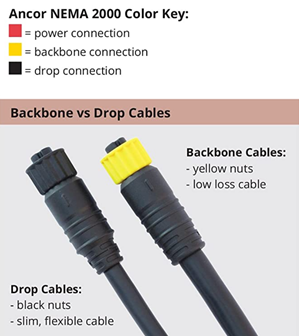
An N2K system is very much a DIY project for a boatowner as long as you do some reading and follow some basic rules. The main components of the N2K network are the backbone cable, tees and drop cables going to each instrument/sensor, a specialized power tee to provide low amperage 12V power to the network, and a terminator at each end of the backbone. The length of the backbone is limited to about 100m while each drop cable is limited to about 5m or 16 feet. This basic backbone can be hooked up to a multi-function display, individual displays, a laptop, or even WiFi using appropriate adaptors. It is easily adaptable to both small and large boats. Because the network is energized with 12Vdc, many devices, particularly low amperage sensors, do not need to be wired separately to 12V. The N2K drop cable provides all the power they need. Other devices that require additional current to operate, like autopilots, displays, and AIS, will need to be wired separately to a 12V source in addition to the drop cable. N2K is not particularly high bandwidth and is not designed for transmission of radar or video. One other important consideration in designing an N2K system is that there are male and female connectors. Each section of drop cable will have one male and one female connector at either end. Likewise with tee connectors. The straight line part of the tee is designed to attach to the backbone, one male and one female end. Thus, the length of the backbone is directional. The right angle part of the tee is designed to attach to a drop cable and is female. Terminators are either male or female.

I started the N2K installation on Terrapin with the purchase of the B&G 508 wind sensor. This sensor actually came bundled with 20m of N2K backbone cable and included a terminator. Because of the length limitations of the drop cable, the backbone must start at the top of the mast if you want to attach mast mounted instruments to your N2K network. Thus, the wind instrument at the top of the mast became the first instrument attached to the backbone. Running the backbone cable down the mast was the most difficult part of the whole installation and I had two pros doing it while they were rigging my new roller furling! The backbone should then be routed through the boat such that every instrument or sensor that you might want to ever attach to the backbone is no further than 16 feet from backbone cable. It is best if you can identify a few zones where groups of tees can be attached. In my installation, there were obvious zones at the nav station behind the breaker panel, a locker below the cockpit, and a locker near the stern.
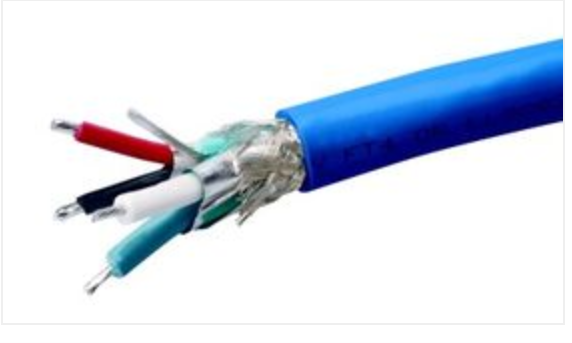
The one mistake I made in designing my N2K system was that I used the single 20m backbone supplied with the wind sensor for entire length of the N2K backbone. This meant that I had to cut the cable twice to insert tees at two of the zones. This required the installation of four N2K connectors. This didn’t seem to be a problem because you can buy “field attachable connectors” from a few different suppliers. I bought the ones sold by Maretron. They make it seem easy to do the attachment but, believe me, it is not! The N2K cable contains 4 insulated wires, one non-insulated wire and a metal sheath, all of which need to be connected to little screws within the connector. To make matters worse, the non-insulated wire needs to be insulated with a tiny length of heat shrink tubing so it doesn’t short out on the other terminals.
The rigger installed the wind sensor at the top of the mast and then fed the N2K backbone down the mast into the cabin using a messenger wire. Even without a connector, the cable was difficult to feed through a narrow spot at the deck. I then pulled the entire 20m of cable down through the mast and routed it through the starboard side of the boat, through the nav station and back to the stern. I then cut the backbone at the locations where I needed tees and set about attaching the field attachable connectors. This was difficult and time consuming and, as I was to find out later, I obviously messed up at least one connector because the network didn’t work.
Next, I connected the power tee and wired it to the Instruments breaker at the nav station. Then I installed a tee in the locker by the cockpit helm and fed a drop cable to my new Zeus 2 MFD. The Zeus 2 was also wired to 12Vdc per the instructions. One of the great things about the Zeus is that it has a built in Network Analyzer, and it was immediately apparent that there was a problem with the N2K network. Since I was not very confident in my field attachable connectors, I suspected these were the cause of the problem. I decided to replace these sections of backbone with shorter cables with factory installed connectors. I purchased these cables as well as extra tees through Ancor Marine. This left my network with only a single field attachable connector at the end of the section of backbone that was routed through the mast. This one was apparently a good connection because the network worked fine once I made this change.
At this point, I had a working N2K network with only wind speed/direction and a Zeus 2 MFD, but with the ability to add devices and sensors as desired. I sailed Terrapin for a season with this setup and got familiar with using the Zeus chartplotter with its great SailSteer wind display. Over the next two sailing seasons, I added a Vesper AIS transponder , a B&G autopilot , B&G 4G Radar, and a B&G depth/speed/temp transducer. For each addition, all I had to do was to add a tee, or multiple tees in the case of the autopilot, to the backbone cable and install the instruments. In each case, the Zeus immediately recognized the added device and also provided the interface to perform calibrations and set other options for each device. While it is possible to mix and match brands on the N2K network, there are also proprietary signals sent through the N2K network and I believe this is why my B&G system worked so seamlessly. That being said, I do have one non-B&G device, the Vesper AIS transponder , and that also works flawlessly.
In summary, when designing your N2K network, first decide the locations in the boat where you will need one or more tees and then purchase separate lengths of backbone with factory installed connectors. You might need to remove a connector to route the cable through the mast or a tight channel, necessitating the installation of a field attachable connector, but try to minimize this. Connect the sections of backbone with one or more tees, provide 12V DC to the power tee, and add a terminator to each end. Finally, a good MFD like the B&G Zeus to tie everything together is one of the best ways to set up your network.
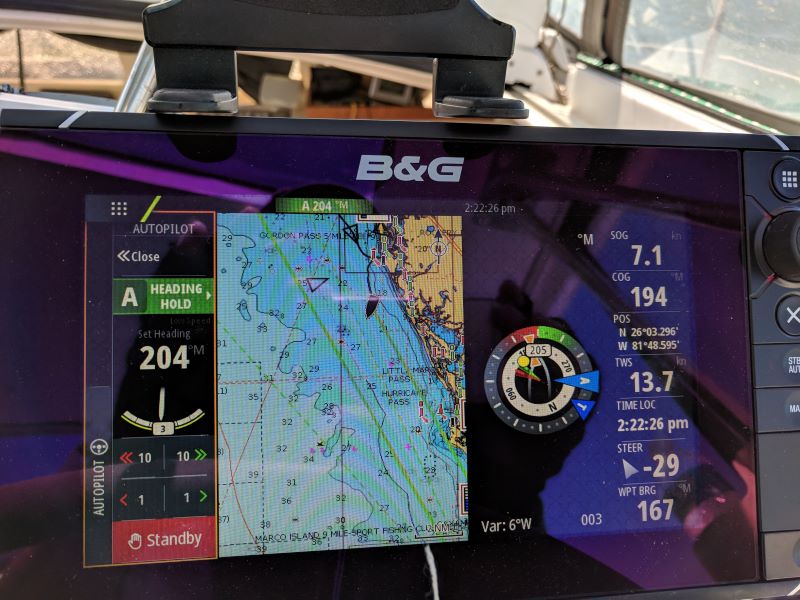
For the helm and the brains of the system, I installed the highly rated B&G Zeus 2 MFD. It comes in 7”, 9” and 12” and I chose the 9” display because it fit perfectly at the helm. These MFDs have the capability to customize windows to display virtually any data present on the N2K system. The most important display is the chartplotter, which shows a nautical chart with your GPS location and the ability to zoom in and out. If you add radar to the system, it will overlay the radar on the chart so you can see exactly what is around you relative to charted objects. If you add an AIS receiver, you can view other ships on the chartplotter that are broadcasting AIS information. The MFD also has a sophisticated control system to run the autopilot and to set navigation routes. The B&G Zeus also has a great panel called SailSteer with key sailing data including vessel heading, wind direction (apparent and true), wind speed (apparent and true), GPS course over ground, speed over ground, etc. There is a ton more that these MFDs can do, but you get the idea.
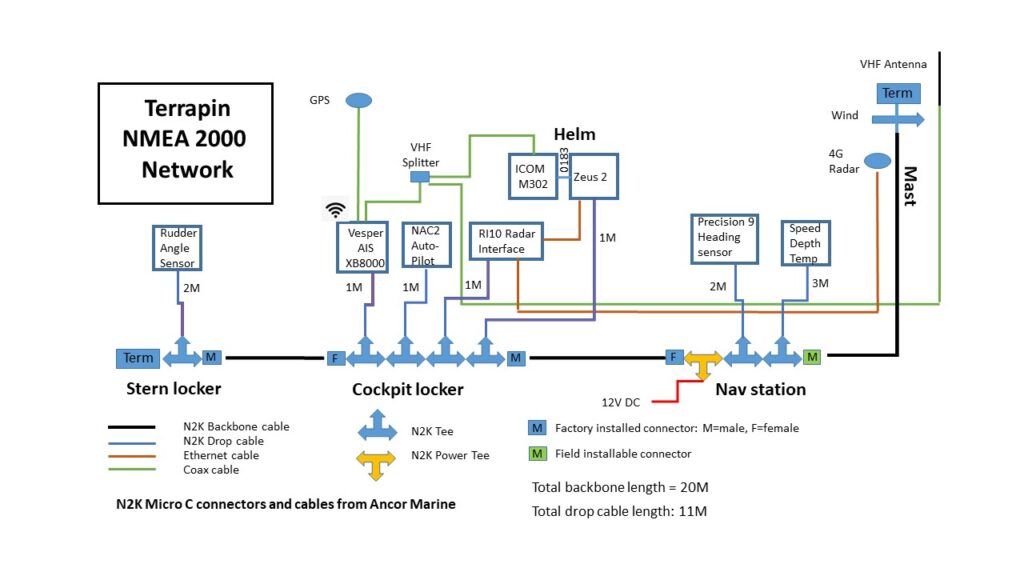
Terrapin battery wiring and charging upgrade
In the Spring of 2019, I spent about 7 days upgrading the battery and charging system of Terrapin. For those wishing to do something similar, I have written a detailed description of my upgrade. Although I have a good foundation knowledge of basic electrical circuits, I needed to familiarize myself with marine electrical systems, particularly as they relate to the cruising sailboat. While there is no one right way to wire a boat, I was able to focus on a series of best-practices that allowed me to design a good charging system.
My main sources were:
- The Boat Owners Mechanical and Electrical Manual, by Nigel Calder
- A great web site operated by Rod Collins at Compass Marine
Marine How To – DIY for Boaters
- Several knowledgeable folks on Cruisers Forum
I actually purchased my Balmar alternator and regulator from Compass Marine. Customer service was great. He gave me great advice prior to purchase to make sure I got the right alternator/regulator combination for my needs and provided help during my installation.
My goal was simple: to create a battery and charging system that would sustain long term cruising away from the dock. To do this, I also carefully considered the charging needs of Terrapin, the existing systems and the typical electrical usage of the crew (Laura and I, and the occasional guests).
Existing equipment:
- House battery bank: 4 6-volt deep cycle lead acid batteries, 216 AH each, wired in series/parallel to produce a 12V bank of 432AH.
- Two stock Hitachi Alternators, internally regulated, 50A.
- A Powerline battery isolator
- Two engine starting batteries, 12V automotive cranking batteries.
- Solar panel, 150W, PWM controller
- Air X wind generator
- A Freedom 20 battery charger from Heart Interface
New equipment installed:
- Balmar 6 series Alternator, 120A, including MC614 regulator and serpentine belt kit.
- Victron Battery monitor, BMV 712 Smart.
- Fusing: Blue Sea MRBF terminal fuse blocks
- Xantrex Echo charger for the start battery
- Tools: FTZ Battery Lug Crimp tool and FTZ battery lugs.
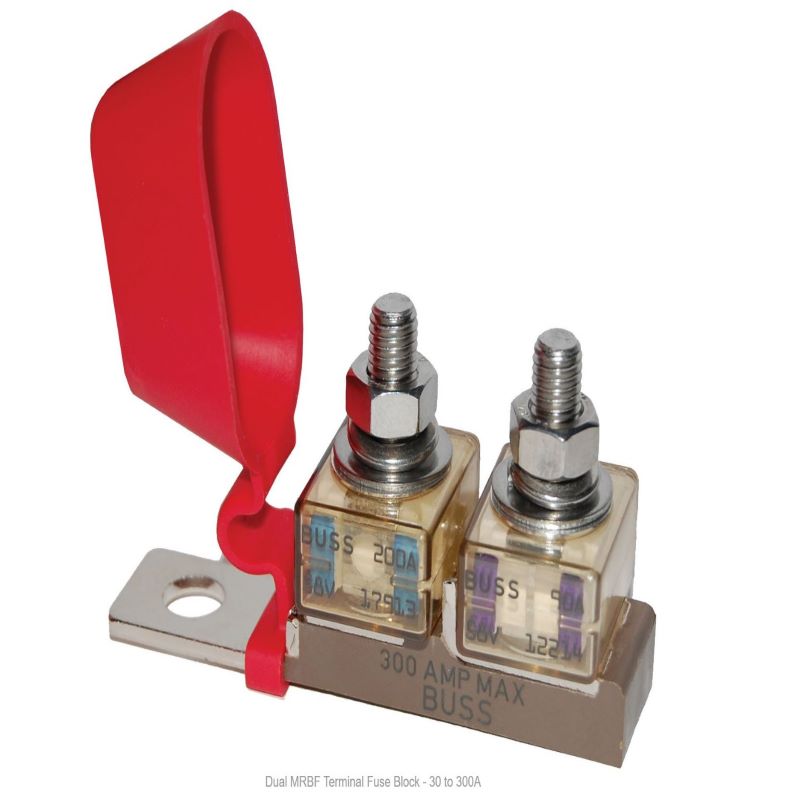
This was not a complete re-do as most of the existing components and charging systems worked, and the batteries themselves were in good shape. This was also phase 1 of an anticipated two-phase upgrade. The main aspect of phase I was an alternator upgrade and a re-wiring of the battery and charging system. This was made a little more complicated in that Terrapin (a catamaran) has two inboard diesel engines, two alternators, two starters, two starting batteries and a four-battery house bank. The house bank were relatively new deep cycle lead acid golf cart batteries.
Many would argue that it is better to upgrade to as much solar as possible and that it is inefficient to run the engines solely to charge the batteries. I agree, but Terrapin is a small cat and there is limited room for additional solar. My existing panel is at the stern, above the dinghy davits. There is room for additional panels on the coach roof, but part of that area is always in shade due to the boom and the stack-pack, or the main sail if it is up. Nevertheless, I do plan to add a panel up there. While I don’t plan on routinely using my engines solely to charge the batteries, I am usually running the engines at least an hour or two every day while cruising, usually to get in and out of an anchorage. Of course, if there is little wind, then I run the engines a considerable amount more. Thus, a high output alternator makes sense to make sure the batteries get as much charging as possible when motoring.
Based on all my reading, my specific goals were as follows:
- Upgrade one of the alternators to a high capacity alternator with an external regulator.
- Run all charging to the house bank: both alternators, solar panel, wind generator, shore power battery charger/inverter.
- Get rid of one of the start batteries and wire the one start battery to both starting motors of the engines.
- Add an echo charger to keep the start battery charged.
- Re-wire the battery switches to allow engines to be started from either the house or start battery, and allow power usage from either battery. With this set-up, the start battery essentially becomes an emergency battery, normally isolated from house loads, but accessible if needed.
The lead acid (LA) battery was invented in 1859 and represents the earliest type of rechargeable battery still in widespread use. In the boating community, the lead acid battery still dominates but they are slowly being replaced by lithium ion, specifically lithium iron phosphate (LFP) batteries. The type of LA batteries that serve has the house storage bank for boats is very different from your typical car battery. They are referred to as deep cycle batteries and are designed for repeated discharging and charging. The most popular batteries for this purpose and the batteries we have on Terrapin are 6V golf-cart batteries, wired in series to produce 12V.
The LA batteries work well if you take care of them, but they have several limitations. They are very heavy, the usable current is only 30-40% of the total amp-hour capacity, they are take a long time to charge to full capacity and they have to be topped off with water periodically. LFP batteries overcome these limitations making them a much better option on a sailboat, but they are considerably more expensive. Because my bank is in good shape, I decided not to go with LFP yet. That will be phase 2.
When away from the dock, the amount of charging available on a boat is often limited. In brief, the number of amps removed x the number of hours (amp-hours) must be replaced by charging. On top of that, as the battery gets to about 80% charged, it begins to accept less current (amps) making it harder and taking much longer for that last 20% of charge. As a result, many LA batteries on boats never get fully charged, and die an early death.
The charging systems on Terrapin consist of 2 alternators, one on each engine, a solar panel and a wind generator. There is also a Honda suitcase generator that can be plugged into the boat’s “shore power” inlet. Of course, when at the dock, the shore power is plugged in and the boat’s AC/DC converter (Xantrex Freedom 20) charges the batteries to the max. After two seasons on Terrapin with prolonged time away from the dock, I realized my charging system was not adequate to keep the batteries fully charged. The solution was to fire up the Honda generator every three days or so and run it for a couple of hours to get the batteries fully charged. The solar and wind generator helped, but were not sufficient to supply the current needed. I could add additional solar panels, but I simply don’t have the space on Terrapin to install the amount of solar needed to be fully self-sufficient. That leaves the alternators. The stock alternators on Terrapin were automotive alternators driven by 18hp diesels. These alternators were designed to supply small amounts of charge to a car battery after it starts the car. This is inadequate to charge deep cycle batteries. So, I decided to replace one of the alternators with a marine rated high output alternator, along with an external regulator to put out the voltage required for good battery charging. Yes, Terrapin is a sailboat, but when out sailing, we are often running the engines 1-2 hours a day just to move the boat in and out of harbors or longer when the wind dies. So, the alternators should be able to handle the full charging needs of the house battery bank. Finally, there were two starting batteries dedicated to starting the diesel engines. These batteries were wired in a confusing way and shared charging sources with the house bank.
Once I decided to upgrade the alternator, it became apparent that the wiring needed changing to make the charging more efficient, and take advantage of new technology.
The original configuration consisted of 4 6V deep cycle golf cart batteries, two in series and then paralleled to get 12v at 430AH, a pretty standard battery configuration. However, the heavy cables connected to the bank were at the wrong positions. They worked, but were not optimal to deliver equal charging or equal loads on all 4 batteries. There were two 12v start batteries with a complicated mix of switches connected to the starters as well as the alternators. There were two stock Hitachi alternators (55A) connected to the house and start batteries via a Powerline diode battery isolator. This resulted in very poor battery charging from the alternators because the battery isolator had a significant voltage drop (see the Compass Marine web site for a good description of the limitations of diode battery isolators and voltage drop). The result was that the house bank never got fully charged when I was motoring, even for long periods of time. There was one 150W solar panel and a wind generator that charged the house bank directly. The fusing was inadequate and located in a very inaccessible place. The fuses were also original equipment (20 years old) and I didn’t trust them.
The upgrade consisted of installing a Balmar 6 series alternator, (120A) and an MC 614 external programmable regulator on the starboard engine along with a serpentine belt kit. I removed the Powerline battery isolator and rewired everything so that all charging went to the house bank, including both alternators. Just because there are two engines does not mean one needs two starting batteries. Starting an engine uses very little of the battery capacity, so a single start battery is all that is needed. I removed one of the start batteries and gave it to Gary down the dock. This also removed about 75lbs of weight from Terrapin.
Another important feature of a good battery and charging system is a battery monitor. I selected a Victron battery monitor. The basic concept is that there is a shunt between the negative battery post and all ground connections to the house bank, whether charging or load. The battery monitor then detects all current running either into or out of the house bank. It also directly senses the battery voltage right at the battery terminals. All of this information is displayed on a small display inside near the fuse panel. I can also connect with my smartphone via Bluetooth and read the information on an app. The original panel on Terrapin has an analog system that attempts to do the same thing, but it is not very accurate and does not keep track of the current in and out. Why is this so important? Consider a day on the boat, out sailing, away from the dock. There will be several loads draining the house bank as well as sources of charging. The refrigerator, nav system, autopilot, WiFi, and various gadgets being charged will all remove amps from the batteries. At the same time, the batteries will be charging from the solar panels, wind generator and alternators if the engines are running. At the end of the day, it is impossible to know the net amp-hours delivered or removed from the house bank. The Victron monitor keeps track of amps-in and amps-out and will give a picture of how discharged or charged the house bank is. Of course it will also tell you the battery voltage, but that is not a very good way of determining state of charge. It also allows one to know at a glance how efficiently the batteries are being charged from, say, the alternators.
If all the charging is now directed to the house bank, how do I charge the single start battery, you ask? This is accomplished with a nifty little device called an Echo Charger. Echo Chargers are good if the battery being charged does not need high amperage charging, like a start battery. After starting two engines, the start battery is only slightly discharged and doesn’t require huge charging currents. The echo charger puts a max of 15 amps into the start battery only if it senses a charging current is available. The advantage here is that it does not require a heavy cable, only a 12-14 AWG wire. The echo charger also has circuitry to prevent over charging of the battery.
Then there is the issue of how to wire the switches to give maximum flexibility to start the engines from either the house or start battery, or to run the various loads from either battery, or isolate either battery in the event that a battery develops a short. After doing a lot of reading, I settled on an ingenious and simple switch arrangement that accomplishes these goals.
To do all this, I bought a large long handled FTZ battery lug crimp tool needed to crimp the lugs on heavy 2/0 battery cable. This way I was able to make my own battery cables and do a neat re-wiring job. I was able to re-use two of the battery switches from the old set up. Fuse options have come a long way in the last 20 years, and there are now many configurations to provide fusing right at the battery post, or blade fuse configurations for smaller wiring. I used several terminal fuse blocks and some blade terminal fuses from Blue Sea Systems.
Since a picture is worth a thousand words, here is the final wiring diagram I ended up with.

In practice, the system works very well. To gauge the charging status of the batteries, I check the Victron Battery monitor frequently. It will tell you the voltage of the house battery bank, or the starter battery. The voltage should be in the range of 12.4 to 13.8 volts. This doesn’t tell you the actual voltage of the battery because the voltage will vary depending on the charging or load on the system. The other thing to look at is the amps going in or out of the system. Finally, the monitor will tell you how much the battery bank was charged or discharged since the last time it was fully charged. The monitor is not smart, so it can provide misleading information on the state of charge of the battery, so the user needs to do the thinking. A fully charged battery that has rested for a while, will show a voltage of about 12.8 volts. It will also not take much current if you supply a charging source. As you are drawing down the charge, keep an eye on the monitor and check it in the morning. The battery voltage should never get below 12.1 volts. Finally, you can check how many net amp-hours you have used in, say, a 24 hour period, i.e. the amps-in minus the amps-out. This will give you an idea of how many amps you need to return to the battery bank the next day.
Let’s say you see a net loss of 100 AH when you get up in the morning. As the bank is charging the next day, keep an eye on the amps going into the bank. Early in the day, the amps being delivered (if the engines are running) will be between 75 and 100 amps. Over time, the amps being accepted by the bank will decline as they become more and more charged. When the monitor shows that 100 AH have been returned to the bank, it is fully charged, more or less.
The starter battery is typically isolated from the loads, so that it will never be run down if a load is accidentally left on. It is also isolated from the charging sources, all except the echo charger. So, the start battery should always read 12.8-13.8 volts if it is healthy. However, the switch arrangement allows one to start the engines from either battery bank, or run the house loads from either bank.
Below is a description of the use of the house battery bank/start battery switches.

Switch position
Start House
On 1
This is the normal operating position. House and start batteries are separate. All charging goes to house. The start battery only receives charging from the echo charger. The only load on the start battery are the starter motors.
Off 1
Use this position if you want to cut off the voltage to the starter motors or to work on the engine (see below for additional precautions). Start battery is isolated. House bank and start battery will receive charging. Engines will not start.
On 2
Use this position if the house bank is dead or shorted out, and you need emergency power, e.g. for nav instruments. The house bank is disconnected from load and the start battery is directly connected to both load and charge (except for the Balmar Alt). The starter battery will receive charging from the port alternator, solar and wind, so this should get you home if the house bank fails. Beware that the start battery has low capacity.
Off 2
There is no good reason to use these switch positions unless trouble shooting the system. Both the house bank and start battery will be disconnected from the loads and most charging except the Balmar.
On Both
Use this position if the starter battery is weak or dead and you want to start the engines using the house bank. This can also be used to “equalize” the start battery using shore power, or to provide extra charging to the start battery from the Balmar alternator. This attaches a “jumper” between house and start. The start will receive charging from all sources, but will also be contributing current, along with the house bank, to all loads. House bank will contribute current to the starters.
Off Both
Use this if the starter battery is dead or shorted out and you need to start the engines. This attaches a jumper between house bank and the starter motors, so that the engines will start from the house batteries.
Off Off
Use this position when leaving the boat for extended periods. This will isolate the house bank from any potential battery drain from the house panel, and the start battery from any potential drain, e.g. from a shorted starter motor. However, the house bank will still be connected to the Balmar alternator, solar panel and wind charger. So the house bank will continue to be charged by the solar panel and the start battery will still receive charging from the echo charger. There will be no power to the house electrical unless the boat is plugged into shore power.
There is currently no way to isolate the Balmar alternator from the house battery bank. I will be installing an Alternator Service switch in the engine bay for this purpose. In the meantime, to work on the either engine, disconnect the negative cable at the Victron shunt near the battery bank, and turn the starter battery switch to off. This will prevent an accidental short at the alternator, or the starter motor.
Making your own water on a boat
Water, water, everywhere, And all the boards did shrink; Water, water, everywhere, Nor any drop to drink. From The Ancient Mariner
November, 2018
The Ancient Mariner had to haul his own water, but thanks to modern technology, we can now convert salt water to fresh water on a sailboat. To me, a watermaker is freedom. Freedom to cruise for extended periods of time without having to worry about pulling into a marina or fuel dock for water. Freedom to take showers and rinse salt off of the boat and equipment without worrying about running out of water. Terrapin is a small catamaran with a modest capacity water tank of 47 gallons. This means that a full tank of water will last the two of us about 3 days of conservative water use: dishes, short showers, stern shower rinse after swimming. Why not carry extra jerry cans of water lashed to the stanchions? In a word, weight. At about 8.3 pounds per gallon, we would have to carry about 370 pounds of water just to double our capacity, not to mention having 6 jerry cans tied around the deck. Catamaran performance is seriously impacted by weight and 370 pounds is a lot. Then there is the fun of carrying around 50 pound jerry cans on the deck of a sailboat, and sometimes in and out of a dinghy. Finally, in some isolated areas as in the Bahamas or Caribbean good quality water is hard to come by. So, for a small boat, and in particular catamarans, watermakers make a lot of sense.
But then there is the issue of how to power it. The heart of a watermaker is a high pressure pump that can put out 800 psi of pressure, and then a low pressure pump to supply sea water to the high pressure pump. Both of these pumps draw a lot of power. There are two flavors of watermakers: AC and DC. AC watermakers can put out more capacity in terms of gallons per hour, but draw more power. This AC power generally has to be provided by an on board generator. DC watermakers use less power but don’t put out as much capacity. The advantage of the DC watermaker is that they can be powered by solar if you have sufficient solar capacity.
Terrapin has 140 watts of solar, not enough to power a high output DC watermaker and it would be difficult to add more solar (although I am still considering it). We do however carry a Honda EU2000 suitcase generator that fits in the stern locker. This generator can power an AC watermaker. Watermakers are also noisy and I wanted the highest capacity possible to limit run time. In terms of capacity, AC watermakers win hands-down.
Cruise RO makes highly rated AC watermakers, the most popular of which can be powered by the Honda 2000 generator and puts out 30 gallons per hour. Most comparable DC watermakers put out less than half that much. The other strong selling point for the Cruise RO is that it is made up of readily available pumps and filters so when components inevitably need replacing, they are easier to source and less expensive. Finally, the owner of the company, Rich Boren has earned a reputation for outstanding customer service. At about $6,000, this is not a decision to make lightly and I believe I did my homework.
How they work:
Most watermakers are modular and require custom, permanent installation on the boat, although one that I considered, the Rainman, is portable and self contained in two suitcases. The heart of the watermaker is the reverse osmosis membrane. This membrane basically filters out the Na+ and Cl- ions and anything else out of salt water and only allows H2O to pass through. Of course to do this, the water has to be under tremendous pressure (800 psi) to force it through the membrane. This is accomplished with a high pressure pump. The membranes are rolled up in a 4’ tube capable of withstanding this pressure. The number of tubes dictates how much fresh water can be produced. My Cruise RO has two pressure vessels. The high pressure pump needs to be supplied a continuous supply of clean seawater, and this is accomplished with a low pressure pump and some pre-filters. All of this is attached together with a bunch of tubing and valves. On top of all this, some watermakers add in electronics and sensors to make it all run automatically and shut off when done. This greatly increases the cost and adds to the complexity, which means less reliability. In my opinion, watermakers are not a “set and forget” device and should be monitored while operating. With two high wattage pumps and 800 psi of pressure, what could possibly go wrong? The cruise RO has an electronic option, but I did not go with it and Rich does not even recommend it for most people.
My installation:
The biggest decision is where to locate the various components on the boat. I chose the head (forward in the starboard hull of the PDQ 32) to locate the valve panel as there is a large flat bulkhead to mount the panel. Furthermore, behind the panel is the forward bow locker with enough space for all the tubing, pre-filters and pumps. I chose to locate the high pressure vessels under the forward settee in the salon. This will allow easy removal when the filters eventually need replacing. Another decision to make is how to supply the watermaker with a supply of sea water. This requires a thru-hull below the waterline. The PDQ 32 has a thru hull in the forward bow locker, but it was supplying sea water to the head, a common Jabsco head with a manual pump. The watermaker requires a dedicated through hull and I couldn’t simply put a tee in the line to supply water to both the head and the watermaker. But then I thought, why flush the toilet with sea water when I will have a good supply of fresh water? Sea water to flush the toilet is problematic in that the sea water itself in the bowl and lines begin to smell like sulfur if allowed to sit for any length of time, and sea water in the holding tank makes the smell all that much worse. My initial thought was to install a new electric head that flushes with fresh water. I may still do that, but for now, all we need to do is add fresh water from the sink to the bowl using a cup, and then pump the head like usual.
The hardest part of the installation was getting the courage to cut two 12” square openings in the bulkhead. After consulting some knowledgeable folk, the consensus was this would not appreciably compromise the structural integrity of the PDQ 32. So, I went ahead. It was a matter of carefully locating all the components to make sure they were in logical and accessible locations. Then I attached all the tubing, and wiring. All in all, it took me about 5 days, with the help of my very capable first mate. I think it would be rare for anyone to have no issues upon start up, and I had some issues, but nothing terribly serious. The first issue I had was getting the low pressure pump to prime and circulate water through the low pressure circuit. After a frustrating hour, I decided to call Rich Boren. I had read about his legendary customer service and was about to find out how true those testimonials were. I knew from reading some forums that he was on his boat in La Paz, Mexico, and was not particularly confident that I would be able to get ahold of him. Well, I was pleasantly surprised when he answered his phone. He walked me through priming the pump and a few other questions I had. I also had a few water leaks and he helped me trouble shoot those. I probably made 4-5 calls to Rich over the next few days getting everything dialed in. His legendary for customer service is well deserved in my opinion.

Cutting holes in the boat is always hard.
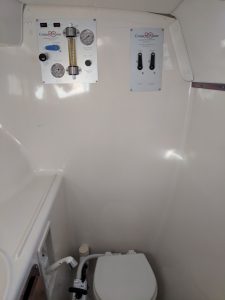
A pretty clean installation. All the tubing and filters are on the other side, but still accessible.

In operation; low pressure pump is at 10 psi, high pressure is at 800 psi and the flow meter reads 0.5 gal/min or 30 gal/hour.
I have now used the watermaker for a season in SW Florida and the Keys, refilling our water tank every 3-4 days. It has worked beautifully and produces very pure water that tastes great. I first start the Honda generator and plug it into the boats AC “shore power inlet”. If the house battery bank is discharged, they will suck up a lot of amperage from the generator, so I need to wait until the batteries are mostly charged before I turn on the watermaker. Once the system is able to route most of the generator output to the watermaker, I turn on the pumps, adjust the flow rate and then test the output using a TDS meter. It takes about a minute for the salinity to be reduced to the drinkable range, about 200ppm. At this point I divert the water to the ships water tank and let it run for until the tank is full, about an 1 ½ hours. During this time, the generator is also able to contribute significant charging to the battery bank in that critical window of 80-100% charge (more on battery charging in another post).
So, yes, the watermaker is definitely freedom. We no longer have to find a dock to tie up to in order to fill our tanks and, while we are always conservative with our water use, we no longer have to ration our water or feel guilty about taking a shower when out cruising.
Sombrero Reef
The Florida Keys Reef is the only living coral reef in the continental United States and the third largest barrier reef system in the world, after the Great Barrier Reef and the Belize Barrier Reef. It runs along the seaward side of the Florida Keys and is typically about 3-4 miles from the islands. Sombrero Reef lies just 4 miles from Boot Key Harbor. There is a cool lighthouse (one of six along the Florida Keys Reef) sitting on top of the reef and lots of mooring buoys surrounding it. We can sail right up to the reef and hook onto a buoy for an afternoon of snorkeling right off the boat.
An interesting tidbit is that the government has decided these lighthouses are no longer necessary and will be donating them for free to interested non-profits. If there are no takers, they will sell them at auction to the general public. Anyone want to own a lighthouse?

Terrapin tied to a mooring buoy at Sombrero Reef.
Keys Fisheries
One of our favorite restaurants in Marathon is Keys Fisheries. Keys Fisheries is a seafood restaurant/bar, seafood market, and wholesale fishery. They supply most of the Florida restaurants with stone crab caught in traps in local waters. Upstairs is a raw bar that serves fresh stone crab and raw oysters. Do we look happy?
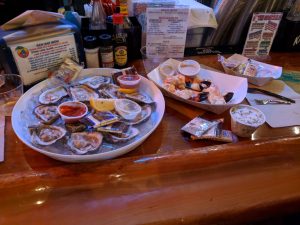
How do you get internet on a boat?
The ability to connect to the internet from our boat is very important to us. Let’s face it, the internet is such a fabulous resource that it is worth the time and effort to make sure we have the best connection possible. Even if you don’t care about reading your email or posting to Facebook, the ability to access weather, anchorage information, or YouTube videos about how to bleed a diesel engine or some other maintenance issue makes the internet an important part of good seamanship. The challenge on a boat is that we are continuously moving from one spot to another and are usually further away from any internet “hot spot” or cell tower than if we were on land. There are also two types of internet access: WiFi hotspots and cellular data. Both have their advantages and disadvantages. WiFi hotspots usually have a password requirement, but if you have the password, the data are free. A typical example is a marina WiFi. The downside is that 100s of other boaters may be using the WiFi also and things can get pretty slow. There is also the security risk of using a public WiFi: anyone with a packet sniffer can steal passwords, credit card numbers etc. The remedy is to use VPN software to make your connection. Cellular data is generally safer, and faster. Cellular data has a much longer range and you can generally receive a cell signal 4-5 miles off shore of most areas in in the US. The downside is, most cellular data plans have some sort of cap on the amount of data you can use before they slow it way down. For these reasons, it is best to have both capabilities on a boat. After doing a ton of reading of Cruisers Forum and other blogs, I settled on a DIY system for Terrapin that does the following:
It has a long-range WiFi radio/antenna on the stern rail that is capable of connecting to WiFi hotspots several miles away.
It has a high gain cellular antenna also mounted on the stern rail that is connected to a dedicated cellular modem inside the boat. We can and do sometimes use our cell phones as hotspots also to connect, but the high gain antenna can pick up cellular data signals at a distance when cell phones cannot connect.
Both of these are connected to a basic router inside the boat that any device can log into and receive the internet from whichever connection is chosen. This can be selected by a simple switch. When we move from one location to another and need to log into a new WiFi hotspot, I can access the long range antenna through my laptop, and see all the available WiFi connections in the area. If I have a password, e.g. from a new marina, I can log into that WiFi. The connection on the boat remains the same. All devices simply log into the boat router with a single password.
For anyone wishing to set up a system like this, you can download the PDF file below with complete instructions on configuring such a system.
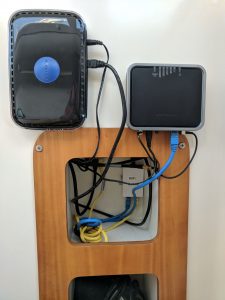
The WiFi installation on Terrapin. The Netgear 4G modem is on the right and the Netgear router is on the left.
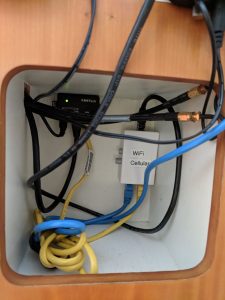
A closeup of the installation showing the WiFi/cellular switch on the right and the POE injector for the Bullet on the left.
Configuring a boat WiFi network
If at first you don’t succeed….
When I purchased new sails for Terrapin, I also bought a spinnaker. The spinnaker is used for downwind sailing when the wind is between 90 and 180 degrees off the bow. Paradoxically dead downwind sailing or “a run” is generally one of the slowest points of sail, mainly because you are relying on your sails to be “pushed” by the wind directly behind them. Conventional main and jib are not really designed for this. Instead, conventional sails are designed to be a curved airfoil, like a vertical airplane wing. The wind passing over the front of the sail provides “forward lift” and propels the boat forward. In some cases, this can propel the boat faster than the wind speed as in the recent Americas Cup catamarans. The spinnaker is a large light balloon like sail that catches the maximum amount of wind from behind to improve downwind sailing performance. It is generally used for light wind of less than 15 knots.
The spinnaker is also somewhat tricky to rig and deploy and I had no experience with them other than reading and watching YouTube videos. We have been on several stretches of long downwind sailing on Terrapin during our recent cruise to the Keys and have been frustrated with the slow speed. Finally, one day I decided to test out the new spinnaker. I think I made every mistake in the book and paid the price. With Laura at the helm, I went to the bow and pulled the spinnaker out of the bow locker. It is in a rather large bag and pretty unwieldly. I hooked it up to a bridle that ran from one bow to the other with a shackle to attach to one of the lower corners of the spinnaker, called the tack. The other lower corner of the spinnaker is called the clew and is where you attach the sheet that runs to the cockpit on the leeward side and controls the shape of the sail. By adjusting both the bridle position side to side and the sheet, I can control the position of the spinnaker and the amount of “ballooning”, or so goes the theory. The spinnaker is in a sock about 40’ long and designed to be raised and unfurled in two steps: 1. Attach the head of the sail to the spinnaker halyard and hoist it up to the top of the mast. 2. Pull on another line running from a cuff around the bottom of the sock to the top of the spinnaker and then back down again. Pulling on this line raises the sock and allows the lightweight nylon spinnaker to unfurl and catch the wind. To douse the spinnaker, you pull the sock back down with the same line. So, I hooked up the tack and clew and raised the sock on the halyard. So far so good. Except that by the time I had done all this, the wind speed had increased to about 15k, gusting to 20. I should have stopped right there. Hindsight is 20/20, right? Well, I raised the sock and all hell broke loose. The sheet running to the cockpit wasn’t secured and came loose, allowing the spinnaker to flap uncontrollably in the strong wind. It started to wrap around the forestay where the genoa is rolled up on a roller furler. I had also left the two genoa sheets attached to the genoa and these quickly became tangled with the spinnaker lines. I tried to bring the sock down but it was jammed. I spent what seemed like an eternity trying to control this crazy flapping spinnaker, but it was probably about 10 minutes. I finally went to the mast and lowered the halyard lowering the whole mess to the trampoline. Exhausted.
Lessons learned:
- Don’t try to fly the spinnaker in wind stronger than 15 knots, at least until you have plenty of experience.
- Attach the sheet and tack more securely.
- Make absolutely sure the sock is free and clear of all lines and on the proper (leeward) side the forestay.
- Remove the genoa or jib sheets so there is no chance of getting tangled
- Clear the deck of all stuff, fenders, docklines, etc.
- Practice with raising the spinnaker at the dock before attempting to use it under sail.
Well, after digesting and re-enacting the scenario in my mind, I finally got the courage to try it again when we were sailing downwind in much lighter wind. This time it worked perfectly! What a good feeling to pull up the sock and see this beautiful sail catch the wind and feel the boat accelerate.
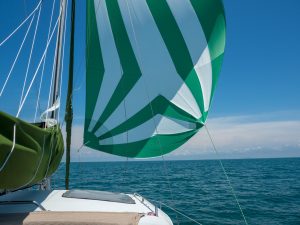
Flying the spinnaker on Terrapin
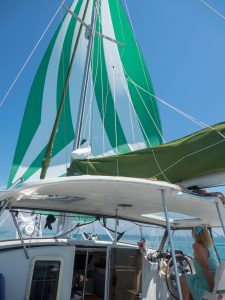
Downwind sailing under spinnaker alone

IMAGES
VIDEO
COMMENTS
The PDQ 32 was kept lightweight- 7,200-pound displacement-through efficient design and the smart use of triaxial cloth, acrylic modified epoxy resin (AME 5000), Klegecell core, and even carbon fiber (in the main beam). As a general rule, fast cats have displacement-to-length (D/L) ratios between 50 and 70, and slow cruisers about 100 to 120.
LENGTH: Traditionally, LOA (length over all) equaled hull length. Today, many builders use LOA to include rail overhangs, bowsprits, etc. and LOD (length on deck) for hull length. That said, LOA may still mean LOD if the builder is being honest and using accepted industry standards developed by groups like the ABYC (American Boat and Yacht Council).
Brand: PDQ 32. Brand: PDQ 32. The PDQ 32 sailing catamaran is one of the best regarded sailboats in this size and class. Was made with twin inboard diesels or 4 stroke outboards. The LRC inboard version is preferred for offshore cruising. With outboards you gain two huge storage lockers under the two main berths, at least a knot faster sailing ...
The PDQ 34 (called the PDQ 32 until the hulls were lengthened in 2003) is a distinctive catamaran trawler whose stable ride and exceptional fuel economy made her a popular boat during her production years. Built in Canada, she's a great choice for cruising enthusiasts looking for an alternative to traditional monohull trawlers.
The PDQ 32 is available in two basic configurations — the Classic version, offered with two retractable 9.9-horsepower four-stroke Yamaha outboard engines cleverly deployed from pods beneath the cockpit lockers, and the LRC (Long Range Cruiser) version, offered with twin 20-horsepower Yanmar inboard diesel sail drives located in shielded ...
Built in Canada this super roomy 32 footer is solid and super easy to sail. She was single handed sailed from Canada to Australia by the previous owner. She ...
We spoke with Aurora and Dennis who have a 1998 PDQ 32 named Serenity that they bought in 2017. They tell us about why they chose the PDQ 32, the strengths and weaknesses of the model, and why it has been the perfect catamaran for them. They compare the PDQ 32 to Geminis, Maine Cat 30, Seawind 1160. Please watch the interview below and read on ...
By Bob Perry. August 25, 2000. The first thing you need to be aware of when checking out the design of a catamaran is that the profile and sail plan drawings are deceptive. The next thing you should focus on is that interior volumes come in odd components compared to monohulls. The PDQ 32. The PDQ 32, designed by Steve Killing, is a small ...
The PDQ 32 is a comfortable family cruising catamaran with two cabins aft that have double berths,seating and a clothes locker. The galley is in the port hull and the head is in the starboard hull. The salon has a centerline table with U shaped seating around.
Find PDQ 32 catamaran for sale on YachtWorld Europe's largest marketplace for boats & yachts. We connect over 10 million boat buyers and sellers each year!
Find PDQ boats for sale in your area & across the world on YachtWorld. Offering the best selection of PDQ boats to choose from. ... 2003 PDQ 34 Power Catamaran. US$199,000. ↓ Price Drop. United Yacht Sales | Merritt Island, Florida. Request Info; New Arrival; 2005 PDQ 34 Power Catamaran. US$274,500. US $2,148/mo.
Pdq 32 is a 31′ 7″ / 9.6 m catamaran sailboat designed by Steve Killing and built by PDQ Yachts starting in 1995. Great choice! Your favorites are temporarily saved for this session.
If you are a boat enthusiast looking to get more information on specs, built, make, etc. of different boats, then here is a complete review of PDQ 32. Built by PDQ Yachts (CAN) and designed by Steve Killing, the boat was first built in 1995. It has a hull type of Catamaran Twin Keel and LOA is 9.63. Its sail area/displacement ratio 21.44.
PDQ Yachts in Whitby, Ontario, Canada, launched the Alan Slater-designed PDQ 32 catamaran in 1994 and built 53 of the boats in the following eight years. Practical Sailor first reviewed the PDQ 32 catamaran in April 1997, which happened to be when the test boat for this review update rolled off the production line. Heres a look at what testers ...
A compilation of footage shot while sailing in the Caribbean on our PDQ 32 catamaran, Zero To Cruising. She is a great boat and has helped us live our dream ...
Download the BoatTrader app. Find 6 PDQ 32 Boats boats for sale near you, including boat prices, photos, and more. For sale by owner, boat dealers and manufacturers - find your boat at Boat Trader!
A visual walkthrough of our 1995 PDQ Sailing Catamaran in St. Augustine, FL.Best small (micro) catamaran with excellent design and build quality.All the feat...
PDQ 32 - By Quentin Warren - Nov 1, 1996. In the world of cruising catamarans, aesthetics take a hit when you cut down on length overall. At issue are a host of conflicting themes — the practical demand for interior volume works against the visual imperative that freeboard be low; the need for bridge deck clearance and standing headroom pushes the cabin profile skyward.
David shared his thoughts on the catamaran's designs. ... I don't think you could go wrong with either the PDQ 36 or PDQ 32 s they are quality built catamarans. We owned a 36'er and have been on a few 32'ers and they both have their pros and cons. We decided on the PDQ 36 as the extra length and beam meant for a more seakindly motion.
Among these new craft are the cruising power catamarans, long awaited by an patient crowd of cruising folks. ... The PDQ 32 is a real world entry in the power cruising game, and offers an affordable, shallow draft, stable platform for those wishing for extended cruising capability. The look of the boat will no doubt cause a lot of dock gawking ...
This Vessel Has Been SOLD. 32' PDQ Altair LRC 1998 located in Solomons, MD. This Long Range Cruiser has twin Yanmar diesels, additional water storage, windlass, Inverter, refrigeration, davits, Caribe dinghy with Yamaha engine, full cockpit enclosure etc. She is well equipped for cruising and all her equipment including galle.
Find 28 PDQ Power Catamaran Boats boats for sale near you, including boat prices, photos, and more. For sale by owner, boat dealers and manufacturers - find your boat at Boat Trader! ... 2024 Aquila 32 Sport. Request a Price. Aquila Yachts. Manufacturer Listing; Price Drop; 2007 Sea Ray 44 Sundacer. $299,995. ↓ Price Drop.
The biggest decision is where to locate the various components on the boat. I chose the head (forward in the starboard hull of the PDQ 32) to locate the valve panel as there is a large flat bulkhead to mount the panel. Furthermore, behind the panel is the forward bow locker with enough space for all the tubing, pre-filters and pumps.